Insolvency Problem Questions and Answers
VerifiedAdded on 2023/06/11
|29
|7522
|247
AI Summary
This article provides answers to common insolvency problem questions and discusses the legal obligations of directors and liquidators. It also covers topics such as equity and debt financing, shares, debentures, and the Personal Property Securities Act of 2009. Desklib offers study material and solved assignments for students.
Contribute Materials
Your contribution can guide someone’s learning journey. Share your
documents today.
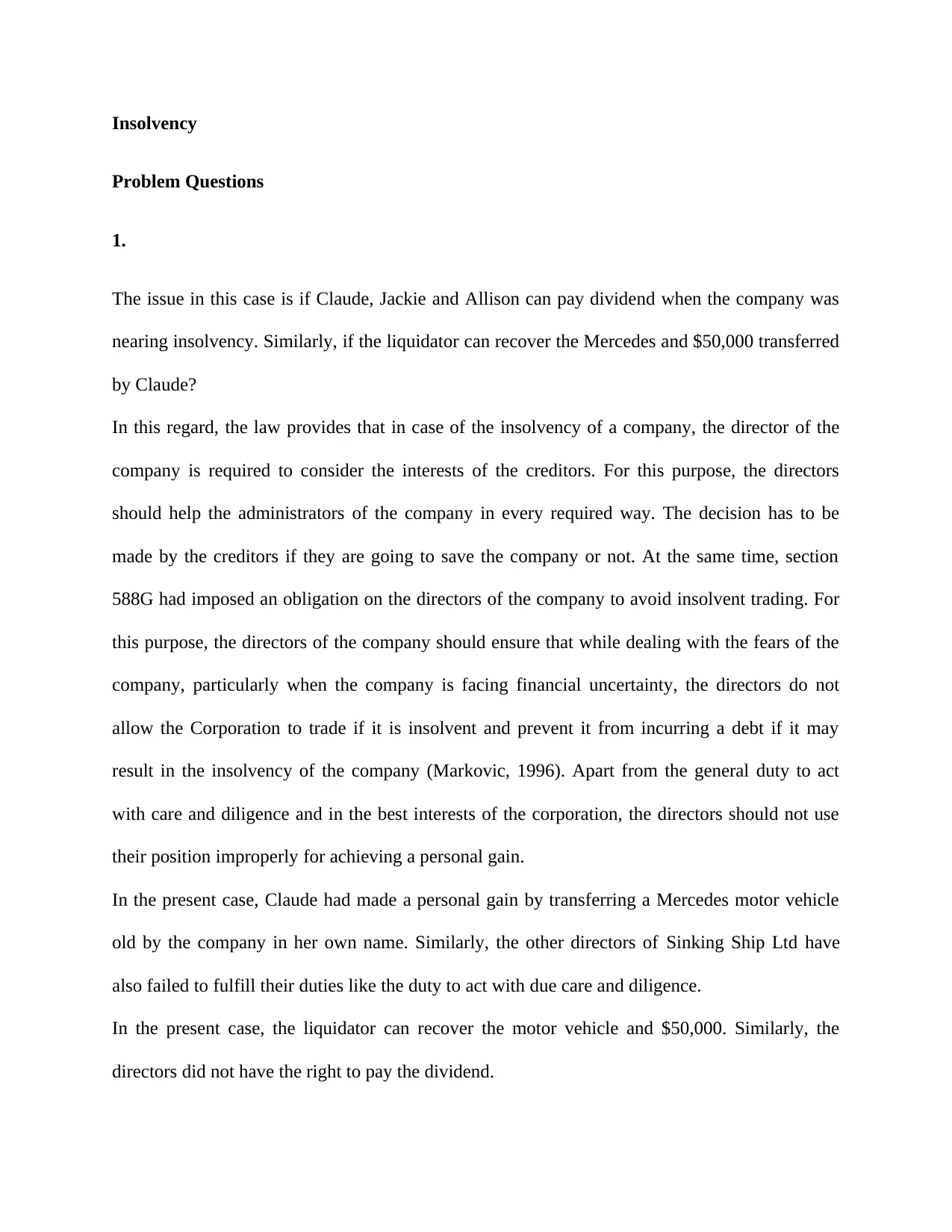
Insolvency
Problem Questions
1.
The issue in this case is if Claude, Jackie and Allison can pay dividend when the company was
nearing insolvency. Similarly, if the liquidator can recover the Mercedes and $50,000 transferred
by Claude?
In this regard, the law provides that in case of the insolvency of a company, the director of the
company is required to consider the interests of the creditors. For this purpose, the directors
should help the administrators of the company in every required way. The decision has to be
made by the creditors if they are going to save the company or not. At the same time, section
588G had imposed an obligation on the directors of the company to avoid insolvent trading. For
this purpose, the directors of the company should ensure that while dealing with the fears of the
company, particularly when the company is facing financial uncertainty, the directors do not
allow the Corporation to trade if it is insolvent and prevent it from incurring a debt if it may
result in the insolvency of the company (Markovic, 1996). Apart from the general duty to act
with care and diligence and in the best interests of the corporation, the directors should not use
their position improperly for achieving a personal gain.
In the present case, Claude had made a personal gain by transferring a Mercedes motor vehicle
old by the company in her own name. Similarly, the other directors of Sinking Ship Ltd have
also failed to fulfill their duties like the duty to act with due care and diligence.
In the present case, the liquidator can recover the motor vehicle and $50,000. Similarly, the
directors did not have the right to pay the dividend.
Problem Questions
1.
The issue in this case is if Claude, Jackie and Allison can pay dividend when the company was
nearing insolvency. Similarly, if the liquidator can recover the Mercedes and $50,000 transferred
by Claude?
In this regard, the law provides that in case of the insolvency of a company, the director of the
company is required to consider the interests of the creditors. For this purpose, the directors
should help the administrators of the company in every required way. The decision has to be
made by the creditors if they are going to save the company or not. At the same time, section
588G had imposed an obligation on the directors of the company to avoid insolvent trading. For
this purpose, the directors of the company should ensure that while dealing with the fears of the
company, particularly when the company is facing financial uncertainty, the directors do not
allow the Corporation to trade if it is insolvent and prevent it from incurring a debt if it may
result in the insolvency of the company (Markovic, 1996). Apart from the general duty to act
with care and diligence and in the best interests of the corporation, the directors should not use
their position improperly for achieving a personal gain.
In the present case, Claude had made a personal gain by transferring a Mercedes motor vehicle
old by the company in her own name. Similarly, the other directors of Sinking Ship Ltd have
also failed to fulfill their duties like the duty to act with due care and diligence.
In the present case, the liquidator can recover the motor vehicle and $50,000. Similarly, the
directors did not have the right to pay the dividend.
Secure Best Marks with AI Grader
Need help grading? Try our AI Grader for instant feedback on your assignments.
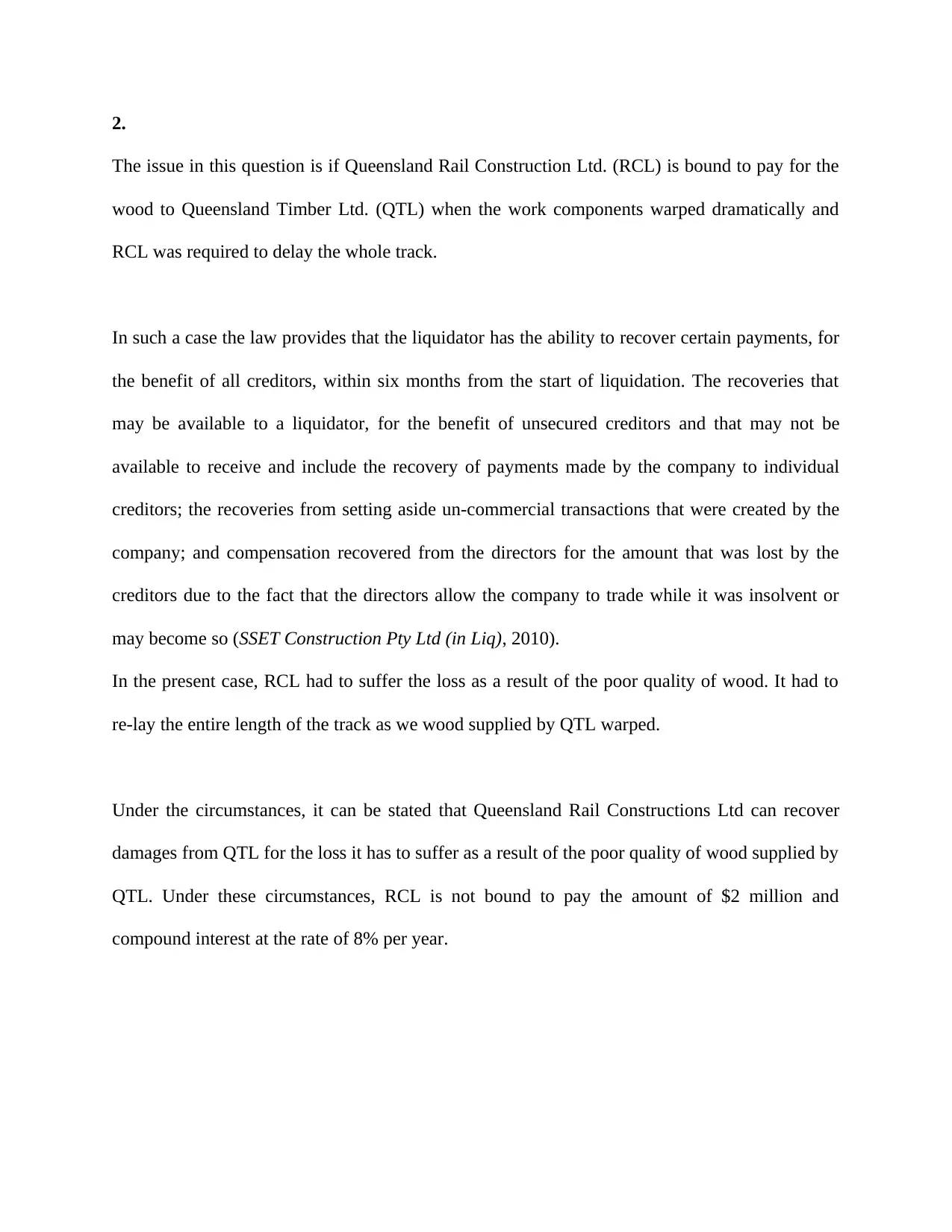
2.
The issue in this question is if Queensland Rail Construction Ltd. (RCL) is bound to pay for the
wood to Queensland Timber Ltd. (QTL) when the work components warped dramatically and
RCL was required to delay the whole track.
In such a case the law provides that the liquidator has the ability to recover certain payments, for
the benefit of all creditors, within six months from the start of liquidation. The recoveries that
may be available to a liquidator, for the benefit of unsecured creditors and that may not be
available to receive and include the recovery of payments made by the company to individual
creditors; the recoveries from setting aside un-commercial transactions that were created by the
company; and compensation recovered from the directors for the amount that was lost by the
creditors due to the fact that the directors allow the company to trade while it was insolvent or
may become so (SSET Construction Pty Ltd (in Liq), 2010).
In the present case, RCL had to suffer the loss as a result of the poor quality of wood. It had to
re-lay the entire length of the track as we wood supplied by QTL warped.
Under the circumstances, it can be stated that Queensland Rail Constructions Ltd can recover
damages from QTL for the loss it has to suffer as a result of the poor quality of wood supplied by
QTL. Under these circumstances, RCL is not bound to pay the amount of $2 million and
compound interest at the rate of 8% per year.
The issue in this question is if Queensland Rail Construction Ltd. (RCL) is bound to pay for the
wood to Queensland Timber Ltd. (QTL) when the work components warped dramatically and
RCL was required to delay the whole track.
In such a case the law provides that the liquidator has the ability to recover certain payments, for
the benefit of all creditors, within six months from the start of liquidation. The recoveries that
may be available to a liquidator, for the benefit of unsecured creditors and that may not be
available to receive and include the recovery of payments made by the company to individual
creditors; the recoveries from setting aside un-commercial transactions that were created by the
company; and compensation recovered from the directors for the amount that was lost by the
creditors due to the fact that the directors allow the company to trade while it was insolvent or
may become so (SSET Construction Pty Ltd (in Liq), 2010).
In the present case, RCL had to suffer the loss as a result of the poor quality of wood. It had to
re-lay the entire length of the track as we wood supplied by QTL warped.
Under the circumstances, it can be stated that Queensland Rail Constructions Ltd can recover
damages from QTL for the loss it has to suffer as a result of the poor quality of wood supplied by
QTL. Under these circumstances, RCL is not bound to pay the amount of $2 million and
compound interest at the rate of 8% per year.
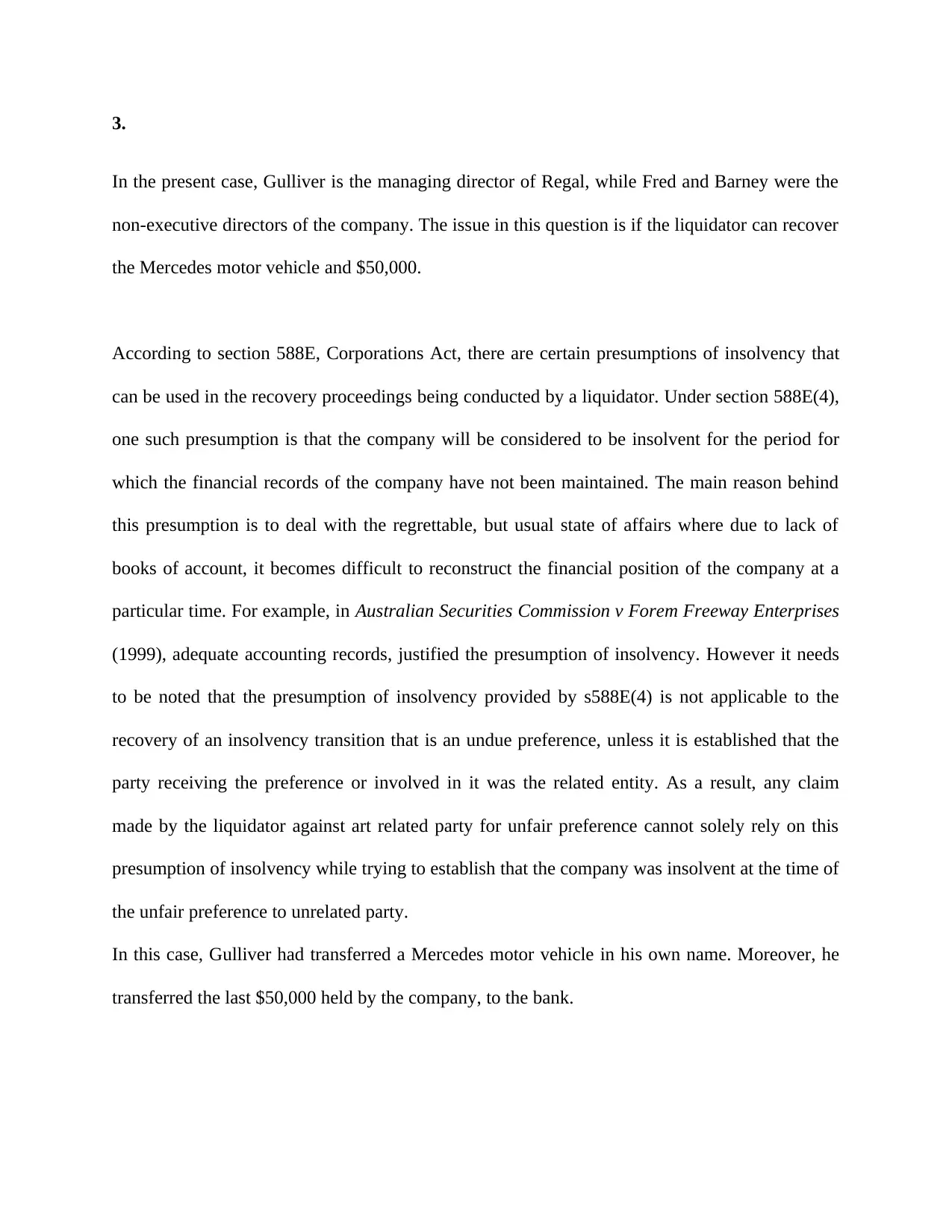
3.
In the present case, Gulliver is the managing director of Regal, while Fred and Barney were the
non-executive directors of the company. The issue in this question is if the liquidator can recover
the Mercedes motor vehicle and $50,000.
According to section 588E, Corporations Act, there are certain presumptions of insolvency that
can be used in the recovery proceedings being conducted by a liquidator. Under section 588E(4),
one such presumption is that the company will be considered to be insolvent for the period for
which the financial records of the company have not been maintained. The main reason behind
this presumption is to deal with the regrettable, but usual state of affairs where due to lack of
books of account, it becomes difficult to reconstruct the financial position of the company at a
particular time. For example, in Australian Securities Commission v Forem Freeway Enterprises
(1999), adequate accounting records, justified the presumption of insolvency. However it needs
to be noted that the presumption of insolvency provided by s588E(4) is not applicable to the
recovery of an insolvency transition that is an undue preference, unless it is established that the
party receiving the preference or involved in it was the related entity. As a result, any claim
made by the liquidator against art related party for unfair preference cannot solely rely on this
presumption of insolvency while trying to establish that the company was insolvent at the time of
the unfair preference to unrelated party.
In this case, Gulliver had transferred a Mercedes motor vehicle in his own name. Moreover, he
transferred the last $50,000 held by the company, to the bank.
In the present case, Gulliver is the managing director of Regal, while Fred and Barney were the
non-executive directors of the company. The issue in this question is if the liquidator can recover
the Mercedes motor vehicle and $50,000.
According to section 588E, Corporations Act, there are certain presumptions of insolvency that
can be used in the recovery proceedings being conducted by a liquidator. Under section 588E(4),
one such presumption is that the company will be considered to be insolvent for the period for
which the financial records of the company have not been maintained. The main reason behind
this presumption is to deal with the regrettable, but usual state of affairs where due to lack of
books of account, it becomes difficult to reconstruct the financial position of the company at a
particular time. For example, in Australian Securities Commission v Forem Freeway Enterprises
(1999), adequate accounting records, justified the presumption of insolvency. However it needs
to be noted that the presumption of insolvency provided by s588E(4) is not applicable to the
recovery of an insolvency transition that is an undue preference, unless it is established that the
party receiving the preference or involved in it was the related entity. As a result, any claim
made by the liquidator against art related party for unfair preference cannot solely rely on this
presumption of insolvency while trying to establish that the company was insolvent at the time of
the unfair preference to unrelated party.
In this case, Gulliver had transferred a Mercedes motor vehicle in his own name. Moreover, he
transferred the last $50,000 held by the company, to the bank.
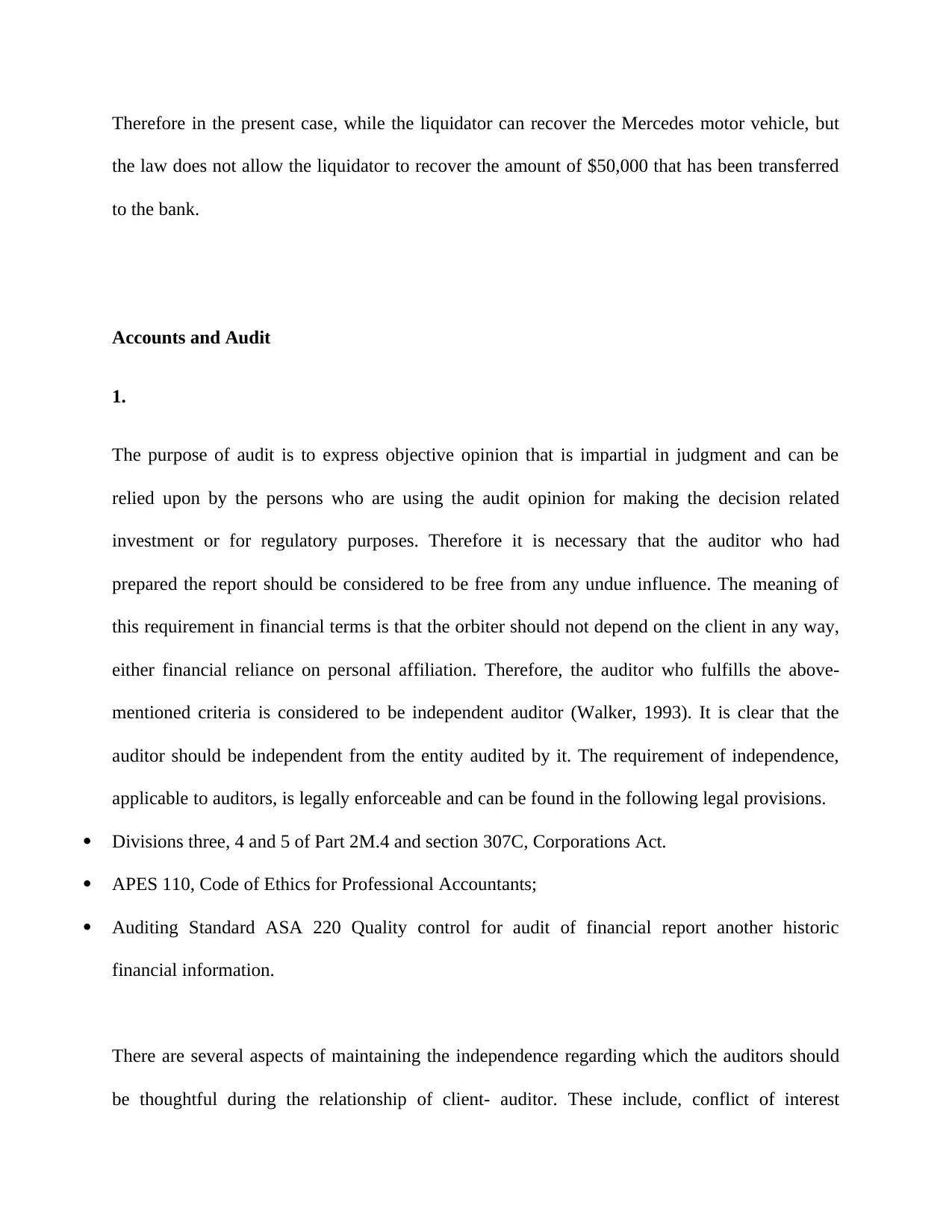
Therefore in the present case, while the liquidator can recover the Mercedes motor vehicle, but
the law does not allow the liquidator to recover the amount of $50,000 that has been transferred
to the bank.
Accounts and Audit
1.
The purpose of audit is to express objective opinion that is impartial in judgment and can be
relied upon by the persons who are using the audit opinion for making the decision related
investment or for regulatory purposes. Therefore it is necessary that the auditor who had
prepared the report should be considered to be free from any undue influence. The meaning of
this requirement in financial terms is that the orbiter should not depend on the client in any way,
either financial reliance on personal affiliation. Therefore, the auditor who fulfills the above-
mentioned criteria is considered to be independent auditor (Walker, 1993). It is clear that the
auditor should be independent from the entity audited by it. The requirement of independence,
applicable to auditors, is legally enforceable and can be found in the following legal provisions.
Divisions three, 4 and 5 of Part 2M.4 and section 307C, Corporations Act.
APES 110, Code of Ethics for Professional Accountants;
Auditing Standard ASA 220 Quality control for audit of financial report another historic
financial information.
There are several aspects of maintaining the independence regarding which the auditors should
be thoughtful during the relationship of client- auditor. These include, conflict of interest
the law does not allow the liquidator to recover the amount of $50,000 that has been transferred
to the bank.
Accounts and Audit
1.
The purpose of audit is to express objective opinion that is impartial in judgment and can be
relied upon by the persons who are using the audit opinion for making the decision related
investment or for regulatory purposes. Therefore it is necessary that the auditor who had
prepared the report should be considered to be free from any undue influence. The meaning of
this requirement in financial terms is that the orbiter should not depend on the client in any way,
either financial reliance on personal affiliation. Therefore, the auditor who fulfills the above-
mentioned criteria is considered to be independent auditor (Walker, 1993). It is clear that the
auditor should be independent from the entity audited by it. The requirement of independence,
applicable to auditors, is legally enforceable and can be found in the following legal provisions.
Divisions three, 4 and 5 of Part 2M.4 and section 307C, Corporations Act.
APES 110, Code of Ethics for Professional Accountants;
Auditing Standard ASA 220 Quality control for audit of financial report another historic
financial information.
There are several aspects of maintaining the independence regarding which the auditors should
be thoughtful during the relationship of client- auditor. These include, conflict of interest
Secure Best Marks with AI Grader
Need help grading? Try our AI Grader for instant feedback on your assignments.

situations and auditor rotation for listed companies (Redmond, 1992). It is also necessary that the
auditors should be diligent in evaluating and identifying the threats to their independence and
apply the necessary safeguards. In case the conflict of interest situations exists for more than
seven days, the auditors should inform ASIC in writing.
2.
The auditors in Australia are exposed to unlimited liability. At present, for professional default.
The main professional accounting bodies in Australia are CPAA and ICAA. These bodies have
confirmed the need for reforms in the field of auditor liability. Traditionally the auditors and
other professional groups have dealt with the issue of unlimited liability exposure for
professional default by using professional indemnity insurance. It is worth mentioning that an
important role is played by insurance in the economy of Australia. Insurance provides the
mechanism to transfer and pool the risk of financial loss to entities with the expertise for
managing the risks involved.
Several defenses are available to auditors for civil as well as criminal liability. Hence, several
ways are available to audit firms to manage their exposure to claims. The most obvious defense
available to the auditors is that they were not negligent. For this purpose, the auditors should
rigorously apply International Standards on Auditing. The auditors should also apply the Code of
Ethics for Professional Accountants. Another defense available to the auditors is by including the
disclaimers of liability.
auditors should be diligent in evaluating and identifying the threats to their independence and
apply the necessary safeguards. In case the conflict of interest situations exists for more than
seven days, the auditors should inform ASIC in writing.
2.
The auditors in Australia are exposed to unlimited liability. At present, for professional default.
The main professional accounting bodies in Australia are CPAA and ICAA. These bodies have
confirmed the need for reforms in the field of auditor liability. Traditionally the auditors and
other professional groups have dealt with the issue of unlimited liability exposure for
professional default by using professional indemnity insurance. It is worth mentioning that an
important role is played by insurance in the economy of Australia. Insurance provides the
mechanism to transfer and pool the risk of financial loss to entities with the expertise for
managing the risks involved.
Several defenses are available to auditors for civil as well as criminal liability. Hence, several
ways are available to audit firms to manage their exposure to claims. The most obvious defense
available to the auditors is that they were not negligent. For this purpose, the auditors should
rigorously apply International Standards on Auditing. The auditors should also apply the Code of
Ethics for Professional Accountants. Another defense available to the auditors is by including the
disclaimers of liability.
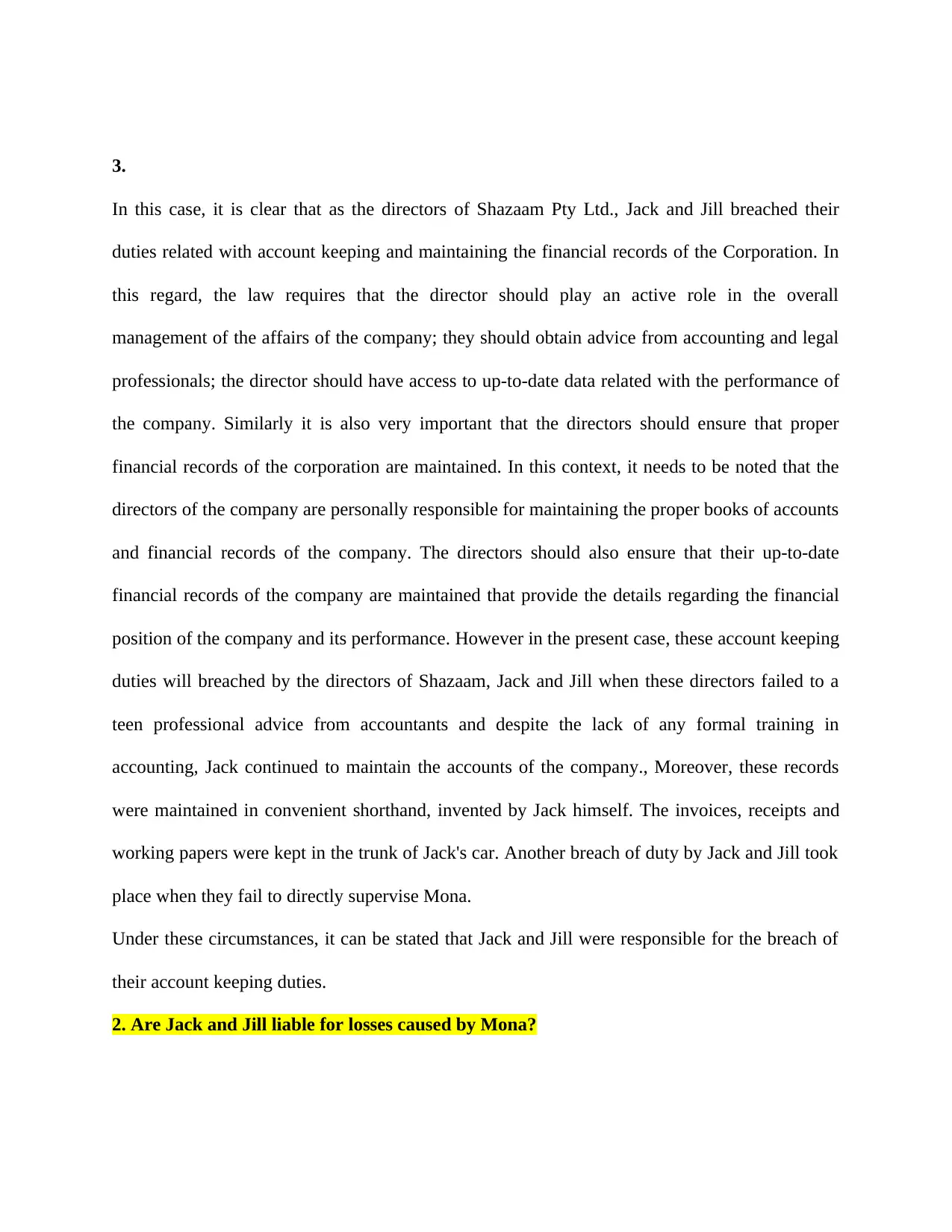
3.
In this case, it is clear that as the directors of Shazaam Pty Ltd., Jack and Jill breached their
duties related with account keeping and maintaining the financial records of the Corporation. In
this regard, the law requires that the director should play an active role in the overall
management of the affairs of the company; they should obtain advice from accounting and legal
professionals; the director should have access to up-to-date data related with the performance of
the company. Similarly it is also very important that the directors should ensure that proper
financial records of the corporation are maintained. In this context, it needs to be noted that the
directors of the company are personally responsible for maintaining the proper books of accounts
and financial records of the company. The directors should also ensure that their up-to-date
financial records of the company are maintained that provide the details regarding the financial
position of the company and its performance. However in the present case, these account keeping
duties will breached by the directors of Shazaam, Jack and Jill when these directors failed to a
teen professional advice from accountants and despite the lack of any formal training in
accounting, Jack continued to maintain the accounts of the company., Moreover, these records
were maintained in convenient shorthand, invented by Jack himself. The invoices, receipts and
working papers were kept in the trunk of Jack's car. Another breach of duty by Jack and Jill took
place when they fail to directly supervise Mona.
Under these circumstances, it can be stated that Jack and Jill were responsible for the breach of
their account keeping duties.
2. Are Jack and Jill liable for losses caused by Mona?
In this case, it is clear that as the directors of Shazaam Pty Ltd., Jack and Jill breached their
duties related with account keeping and maintaining the financial records of the Corporation. In
this regard, the law requires that the director should play an active role in the overall
management of the affairs of the company; they should obtain advice from accounting and legal
professionals; the director should have access to up-to-date data related with the performance of
the company. Similarly it is also very important that the directors should ensure that proper
financial records of the corporation are maintained. In this context, it needs to be noted that the
directors of the company are personally responsible for maintaining the proper books of accounts
and financial records of the company. The directors should also ensure that their up-to-date
financial records of the company are maintained that provide the details regarding the financial
position of the company and its performance. However in the present case, these account keeping
duties will breached by the directors of Shazaam, Jack and Jill when these directors failed to a
teen professional advice from accountants and despite the lack of any formal training in
accounting, Jack continued to maintain the accounts of the company., Moreover, these records
were maintained in convenient shorthand, invented by Jack himself. The invoices, receipts and
working papers were kept in the trunk of Jack's car. Another breach of duty by Jack and Jill took
place when they fail to directly supervise Mona.
Under these circumstances, it can be stated that Jack and Jill were responsible for the breach of
their account keeping duties.
2. Are Jack and Jill liable for losses caused by Mona?
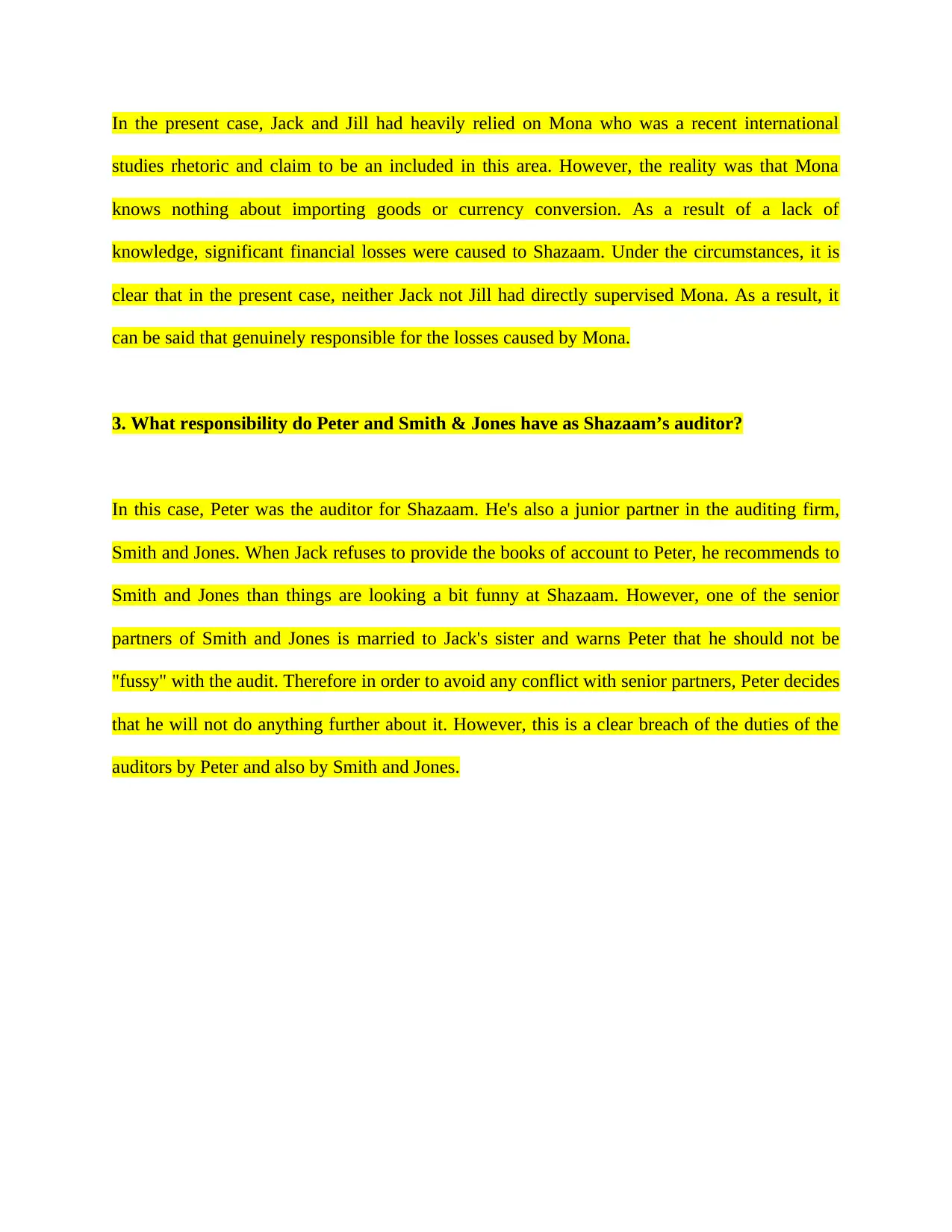
In the present case, Jack and Jill had heavily relied on Mona who was a recent international
studies rhetoric and claim to be an included in this area. However, the reality was that Mona
knows nothing about importing goods or currency conversion. As a result of a lack of
knowledge, significant financial losses were caused to Shazaam. Under the circumstances, it is
clear that in the present case, neither Jack not Jill had directly supervised Mona. As a result, it
can be said that genuinely responsible for the losses caused by Mona.
3. What responsibility do Peter and Smith & Jones have as Shazaam’s auditor?
In this case, Peter was the auditor for Shazaam. He's also a junior partner in the auditing firm,
Smith and Jones. When Jack refuses to provide the books of account to Peter, he recommends to
Smith and Jones than things are looking a bit funny at Shazaam. However, one of the senior
partners of Smith and Jones is married to Jack's sister and warns Peter that he should not be
"fussy" with the audit. Therefore in order to avoid any conflict with senior partners, Peter decides
that he will not do anything further about it. However, this is a clear breach of the duties of the
auditors by Peter and also by Smith and Jones.
studies rhetoric and claim to be an included in this area. However, the reality was that Mona
knows nothing about importing goods or currency conversion. As a result of a lack of
knowledge, significant financial losses were caused to Shazaam. Under the circumstances, it is
clear that in the present case, neither Jack not Jill had directly supervised Mona. As a result, it
can be said that genuinely responsible for the losses caused by Mona.
3. What responsibility do Peter and Smith & Jones have as Shazaam’s auditor?
In this case, Peter was the auditor for Shazaam. He's also a junior partner in the auditing firm,
Smith and Jones. When Jack refuses to provide the books of account to Peter, he recommends to
Smith and Jones than things are looking a bit funny at Shazaam. However, one of the senior
partners of Smith and Jones is married to Jack's sister and warns Peter that he should not be
"fussy" with the audit. Therefore in order to avoid any conflict with senior partners, Peter decides
that he will not do anything further about it. However, this is a clear breach of the duties of the
auditors by Peter and also by Smith and Jones.
Paraphrase This Document
Need a fresh take? Get an instant paraphrase of this document with our AI Paraphraser
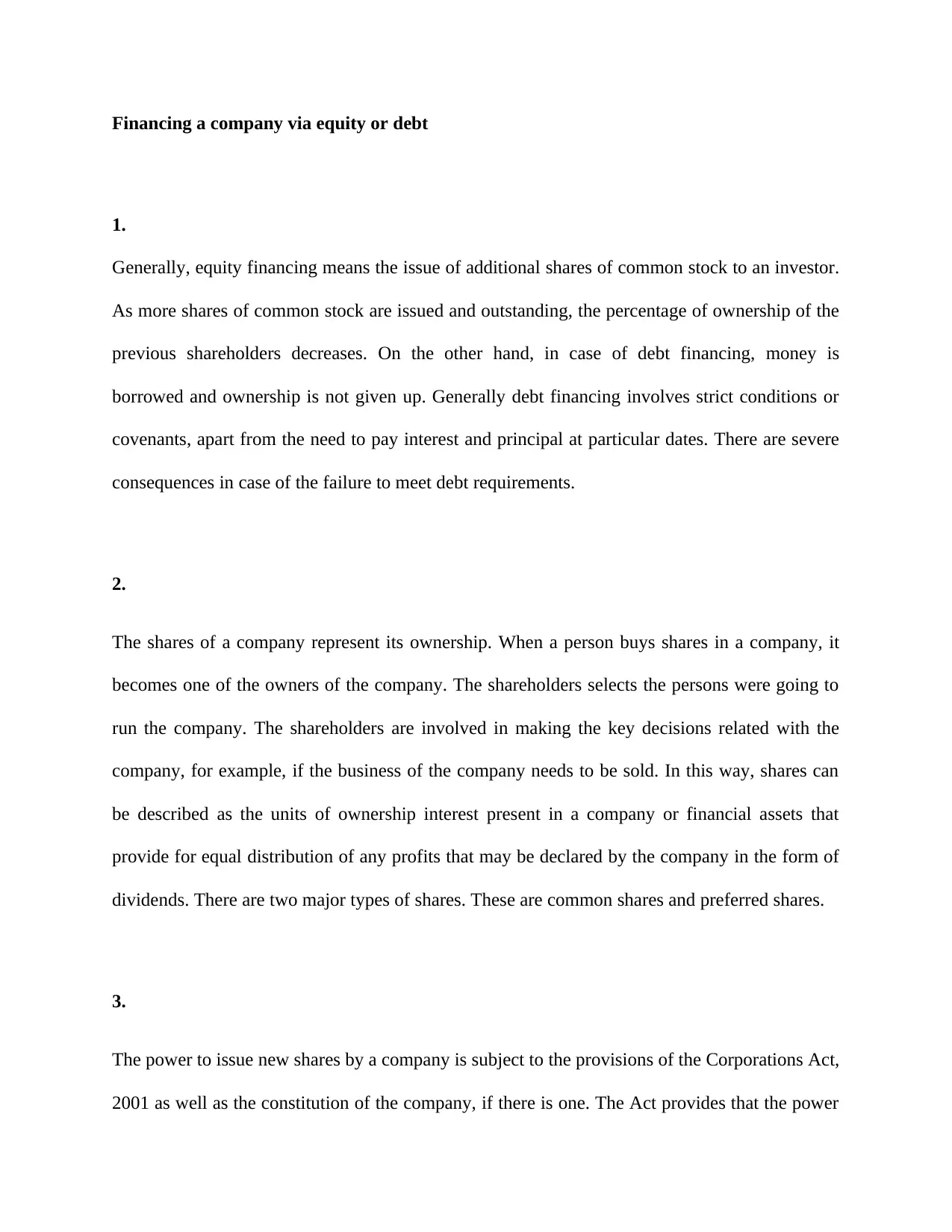
Financing a company via equity or debt
1.
Generally, equity financing means the issue of additional shares of common stock to an investor.
As more shares of common stock are issued and outstanding, the percentage of ownership of the
previous shareholders decreases. On the other hand, in case of debt financing, money is
borrowed and ownership is not given up. Generally debt financing involves strict conditions or
covenants, apart from the need to pay interest and principal at particular dates. There are severe
consequences in case of the failure to meet debt requirements.
2.
The shares of a company represent its ownership. When a person buys shares in a company, it
becomes one of the owners of the company. The shareholders selects the persons were going to
run the company. The shareholders are involved in making the key decisions related with the
company, for example, if the business of the company needs to be sold. In this way, shares can
be described as the units of ownership interest present in a company or financial assets that
provide for equal distribution of any profits that may be declared by the company in the form of
dividends. There are two major types of shares. These are common shares and preferred shares.
3.
The power to issue new shares by a company is subject to the provisions of the Corporations Act,
2001 as well as the constitution of the company, if there is one. The Act provides that the power
1.
Generally, equity financing means the issue of additional shares of common stock to an investor.
As more shares of common stock are issued and outstanding, the percentage of ownership of the
previous shareholders decreases. On the other hand, in case of debt financing, money is
borrowed and ownership is not given up. Generally debt financing involves strict conditions or
covenants, apart from the need to pay interest and principal at particular dates. There are severe
consequences in case of the failure to meet debt requirements.
2.
The shares of a company represent its ownership. When a person buys shares in a company, it
becomes one of the owners of the company. The shareholders selects the persons were going to
run the company. The shareholders are involved in making the key decisions related with the
company, for example, if the business of the company needs to be sold. In this way, shares can
be described as the units of ownership interest present in a company or financial assets that
provide for equal distribution of any profits that may be declared by the company in the form of
dividends. There are two major types of shares. These are common shares and preferred shares.
3.
The power to issue new shares by a company is subject to the provisions of the Corporations Act,
2001 as well as the constitution of the company, if there is one. The Act provides that the power
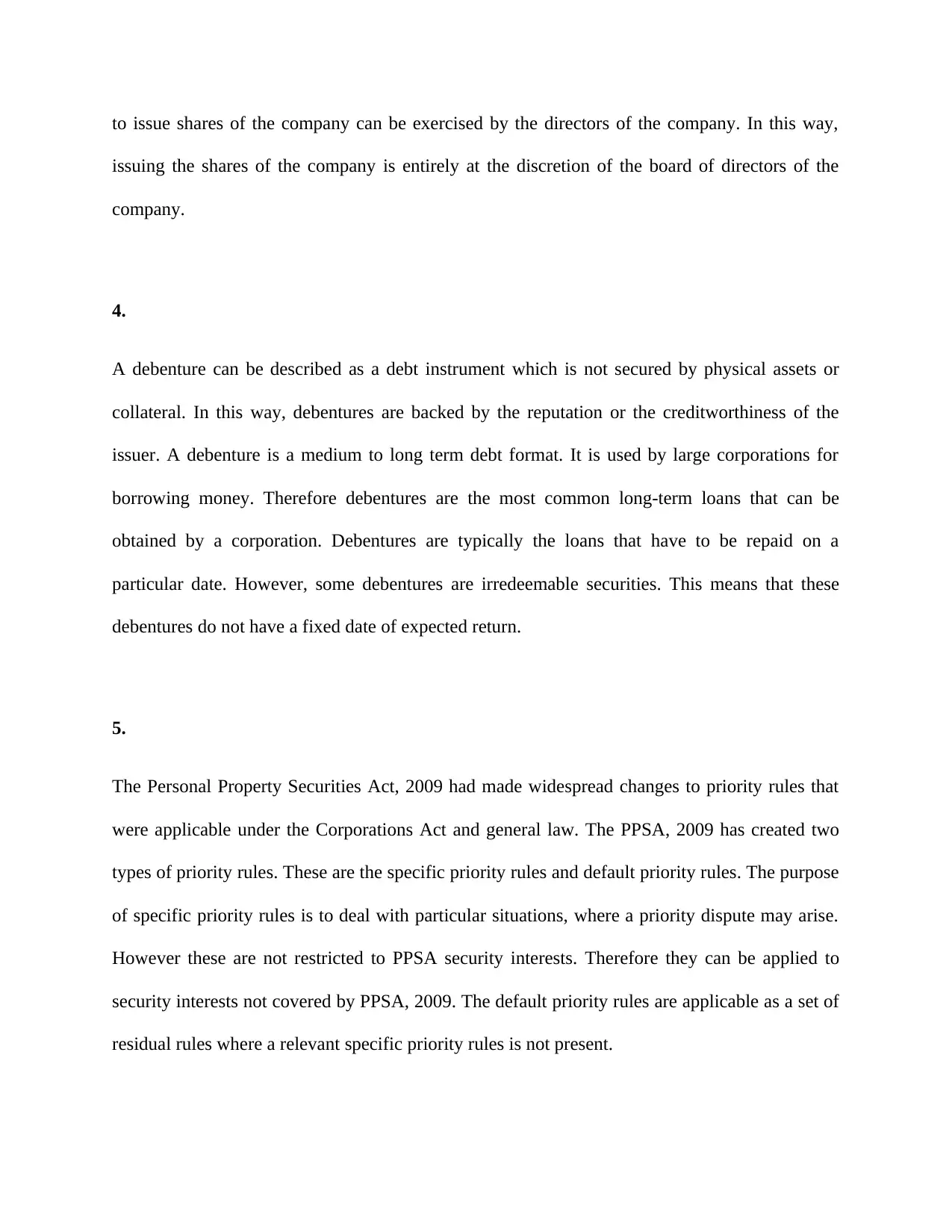
to issue shares of the company can be exercised by the directors of the company. In this way,
issuing the shares of the company is entirely at the discretion of the board of directors of the
company.
4.
A debenture can be described as a debt instrument which is not secured by physical assets or
collateral. In this way, debentures are backed by the reputation or the creditworthiness of the
issuer. A debenture is a medium to long term debt format. It is used by large corporations for
borrowing money. Therefore debentures are the most common long-term loans that can be
obtained by a corporation. Debentures are typically the loans that have to be repaid on a
particular date. However, some debentures are irredeemable securities. This means that these
debentures do not have a fixed date of expected return.
5.
The Personal Property Securities Act, 2009 had made widespread changes to priority rules that
were applicable under the Corporations Act and general law. The PPSA, 2009 has created two
types of priority rules. These are the specific priority rules and default priority rules. The purpose
of specific priority rules is to deal with particular situations, where a priority dispute may arise.
However these are not restricted to PPSA security interests. Therefore they can be applied to
security interests not covered by PPSA, 2009. The default priority rules are applicable as a set of
residual rules where a relevant specific priority rules is not present.
issuing the shares of the company is entirely at the discretion of the board of directors of the
company.
4.
A debenture can be described as a debt instrument which is not secured by physical assets or
collateral. In this way, debentures are backed by the reputation or the creditworthiness of the
issuer. A debenture is a medium to long term debt format. It is used by large corporations for
borrowing money. Therefore debentures are the most common long-term loans that can be
obtained by a corporation. Debentures are typically the loans that have to be repaid on a
particular date. However, some debentures are irredeemable securities. This means that these
debentures do not have a fixed date of expected return.
5.
The Personal Property Securities Act, 2009 had made widespread changes to priority rules that
were applicable under the Corporations Act and general law. The PPSA, 2009 has created two
types of priority rules. These are the specific priority rules and default priority rules. The purpose
of specific priority rules is to deal with particular situations, where a priority dispute may arise.
However these are not restricted to PPSA security interests. Therefore they can be applied to
security interests not covered by PPSA, 2009. The default priority rules are applicable as a set of
residual rules where a relevant specific priority rules is not present.
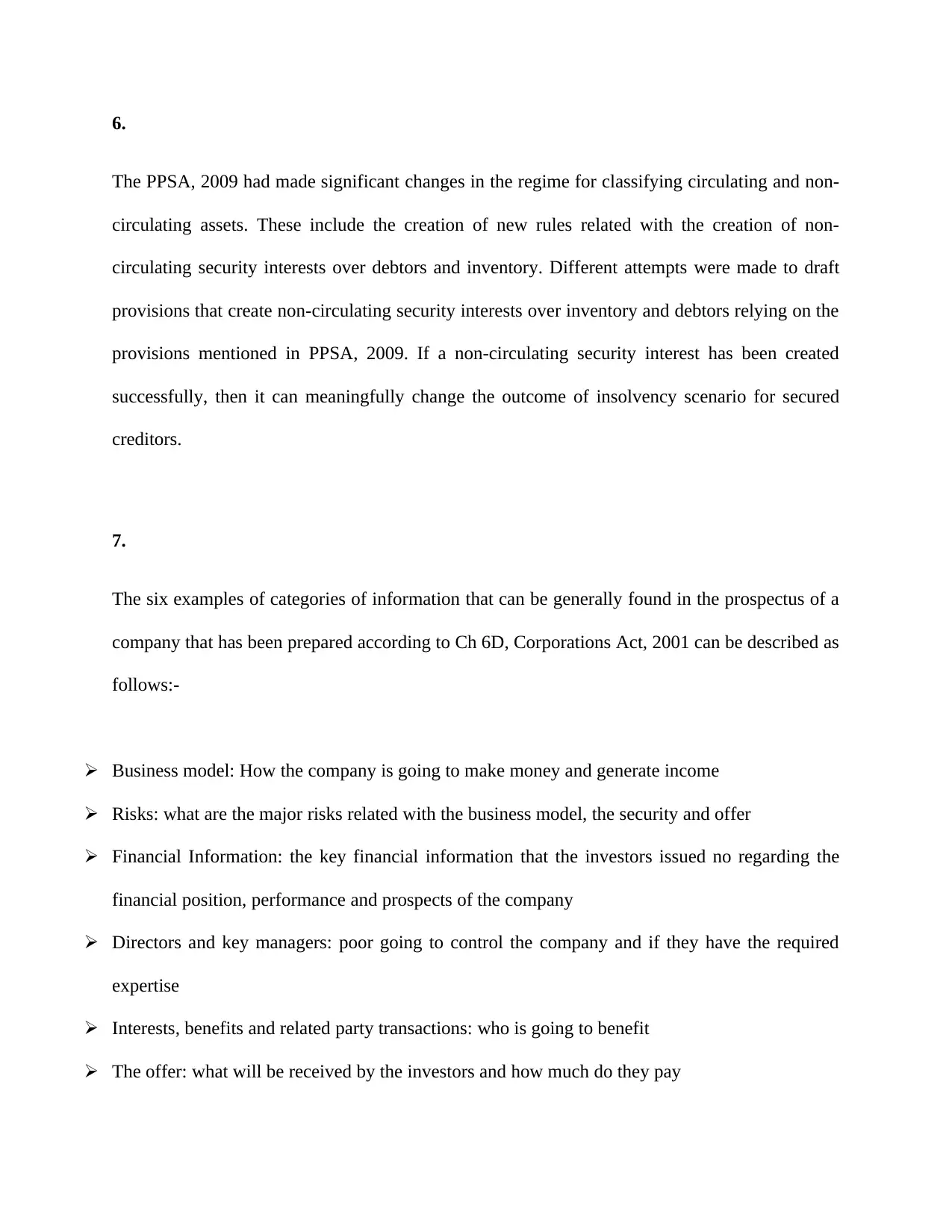
6.
The PPSA, 2009 had made significant changes in the regime for classifying circulating and non-
circulating assets. These include the creation of new rules related with the creation of non-
circulating security interests over debtors and inventory. Different attempts were made to draft
provisions that create non-circulating security interests over inventory and debtors relying on the
provisions mentioned in PPSA, 2009. If a non-circulating security interest has been created
successfully, then it can meaningfully change the outcome of insolvency scenario for secured
creditors.
7.
The six examples of categories of information that can be generally found in the prospectus of a
company that has been prepared according to Ch 6D, Corporations Act, 2001 can be described as
follows:-
Business model: How the company is going to make money and generate income
Risks: what are the major risks related with the business model, the security and offer
Financial Information: the key financial information that the investors issued no regarding the
financial position, performance and prospects of the company
Directors and key managers: poor going to control the company and if they have the required
expertise
Interests, benefits and related party transactions: who is going to benefit
The offer: what will be received by the investors and how much do they pay
The PPSA, 2009 had made significant changes in the regime for classifying circulating and non-
circulating assets. These include the creation of new rules related with the creation of non-
circulating security interests over debtors and inventory. Different attempts were made to draft
provisions that create non-circulating security interests over inventory and debtors relying on the
provisions mentioned in PPSA, 2009. If a non-circulating security interest has been created
successfully, then it can meaningfully change the outcome of insolvency scenario for secured
creditors.
7.
The six examples of categories of information that can be generally found in the prospectus of a
company that has been prepared according to Ch 6D, Corporations Act, 2001 can be described as
follows:-
Business model: How the company is going to make money and generate income
Risks: what are the major risks related with the business model, the security and offer
Financial Information: the key financial information that the investors issued no regarding the
financial position, performance and prospects of the company
Directors and key managers: poor going to control the company and if they have the required
expertise
Interests, benefits and related party transactions: who is going to benefit
The offer: what will be received by the investors and how much do they pay
Secure Best Marks with AI Grader
Need help grading? Try our AI Grader for instant feedback on your assignments.
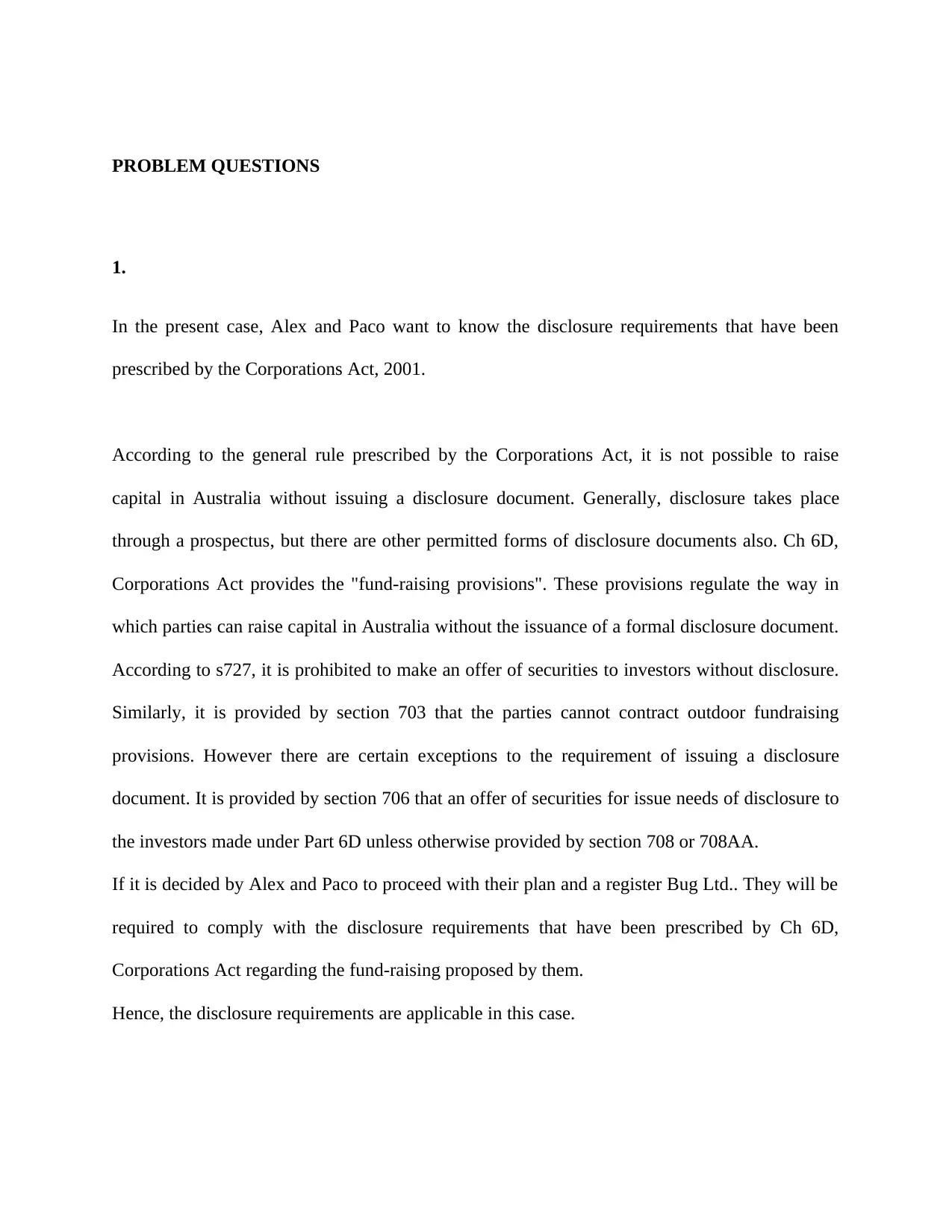
PROBLEM QUESTIONS
1.
In the present case, Alex and Paco want to know the disclosure requirements that have been
prescribed by the Corporations Act, 2001.
According to the general rule prescribed by the Corporations Act, it is not possible to raise
capital in Australia without issuing a disclosure document. Generally, disclosure takes place
through a prospectus, but there are other permitted forms of disclosure documents also. Ch 6D,
Corporations Act provides the "fund-raising provisions". These provisions regulate the way in
which parties can raise capital in Australia without the issuance of a formal disclosure document.
According to s727, it is prohibited to make an offer of securities to investors without disclosure.
Similarly, it is provided by section 703 that the parties cannot contract outdoor fundraising
provisions. However there are certain exceptions to the requirement of issuing a disclosure
document. It is provided by section 706 that an offer of securities for issue needs of disclosure to
the investors made under Part 6D unless otherwise provided by section 708 or 708AA.
If it is decided by Alex and Paco to proceed with their plan and a register Bug Ltd.. They will be
required to comply with the disclosure requirements that have been prescribed by Ch 6D,
Corporations Act regarding the fund-raising proposed by them.
Hence, the disclosure requirements are applicable in this case.
1.
In the present case, Alex and Paco want to know the disclosure requirements that have been
prescribed by the Corporations Act, 2001.
According to the general rule prescribed by the Corporations Act, it is not possible to raise
capital in Australia without issuing a disclosure document. Generally, disclosure takes place
through a prospectus, but there are other permitted forms of disclosure documents also. Ch 6D,
Corporations Act provides the "fund-raising provisions". These provisions regulate the way in
which parties can raise capital in Australia without the issuance of a formal disclosure document.
According to s727, it is prohibited to make an offer of securities to investors without disclosure.
Similarly, it is provided by section 703 that the parties cannot contract outdoor fundraising
provisions. However there are certain exceptions to the requirement of issuing a disclosure
document. It is provided by section 706 that an offer of securities for issue needs of disclosure to
the investors made under Part 6D unless otherwise provided by section 708 or 708AA.
If it is decided by Alex and Paco to proceed with their plan and a register Bug Ltd.. They will be
required to comply with the disclosure requirements that have been prescribed by Ch 6D,
Corporations Act regarding the fund-raising proposed by them.
Hence, the disclosure requirements are applicable in this case.
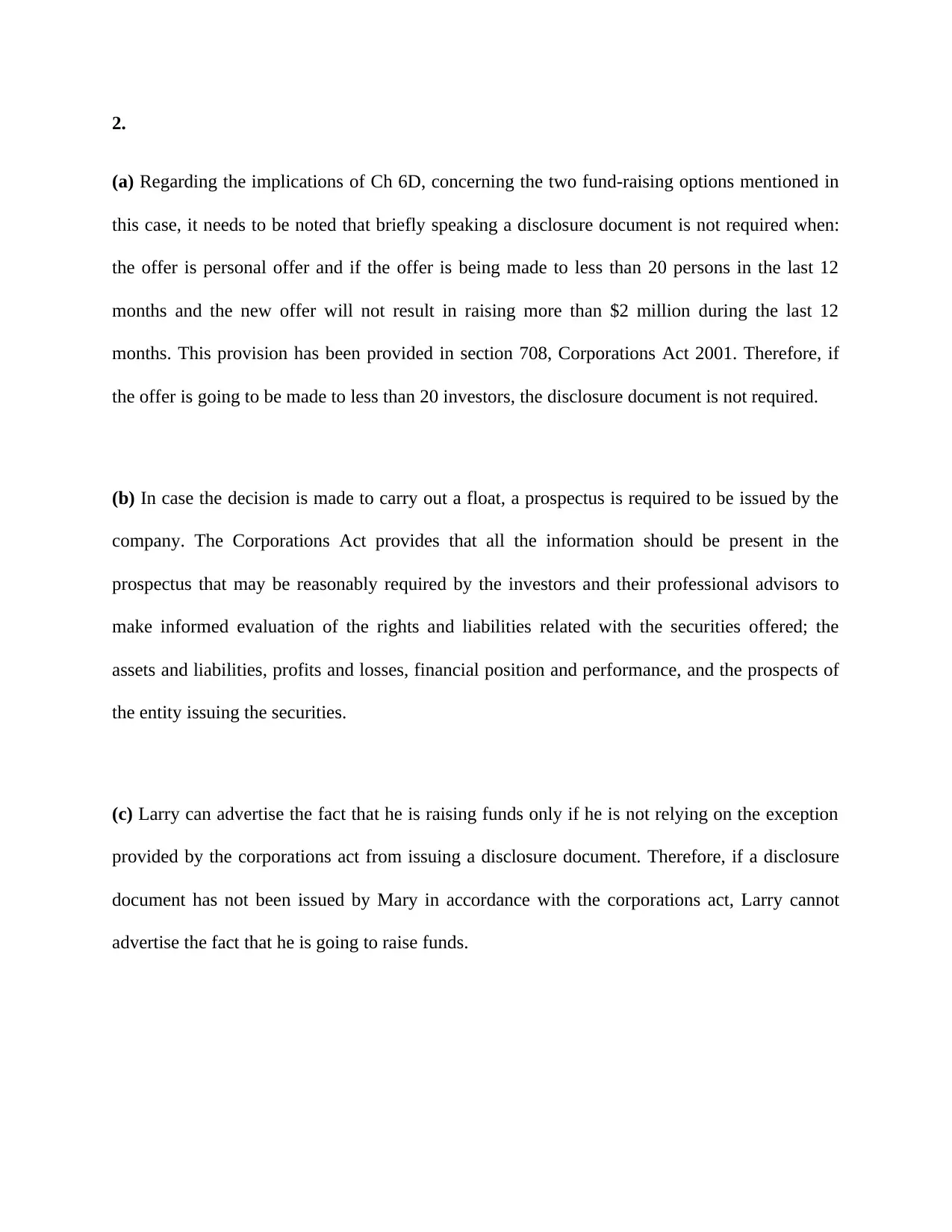
2.
(a) Regarding the implications of Ch 6D, concerning the two fund-raising options mentioned in
this case, it needs to be noted that briefly speaking a disclosure document is not required when:
the offer is personal offer and if the offer is being made to less than 20 persons in the last 12
months and the new offer will not result in raising more than $2 million during the last 12
months. This provision has been provided in section 708, Corporations Act 2001. Therefore, if
the offer is going to be made to less than 20 investors, the disclosure document is not required.
(b) In case the decision is made to carry out a float, a prospectus is required to be issued by the
company. The Corporations Act provides that all the information should be present in the
prospectus that may be reasonably required by the investors and their professional advisors to
make informed evaluation of the rights and liabilities related with the securities offered; the
assets and liabilities, profits and losses, financial position and performance, and the prospects of
the entity issuing the securities.
(c) Larry can advertise the fact that he is raising funds only if he is not relying on the exception
provided by the corporations act from issuing a disclosure document. Therefore, if a disclosure
document has not been issued by Mary in accordance with the corporations act, Larry cannot
advertise the fact that he is going to raise funds.
(a) Regarding the implications of Ch 6D, concerning the two fund-raising options mentioned in
this case, it needs to be noted that briefly speaking a disclosure document is not required when:
the offer is personal offer and if the offer is being made to less than 20 persons in the last 12
months and the new offer will not result in raising more than $2 million during the last 12
months. This provision has been provided in section 708, Corporations Act 2001. Therefore, if
the offer is going to be made to less than 20 investors, the disclosure document is not required.
(b) In case the decision is made to carry out a float, a prospectus is required to be issued by the
company. The Corporations Act provides that all the information should be present in the
prospectus that may be reasonably required by the investors and their professional advisors to
make informed evaluation of the rights and liabilities related with the securities offered; the
assets and liabilities, profits and losses, financial position and performance, and the prospects of
the entity issuing the securities.
(c) Larry can advertise the fact that he is raising funds only if he is not relying on the exception
provided by the corporations act from issuing a disclosure document. Therefore, if a disclosure
document has not been issued by Mary in accordance with the corporations act, Larry cannot
advertise the fact that he is going to raise funds.
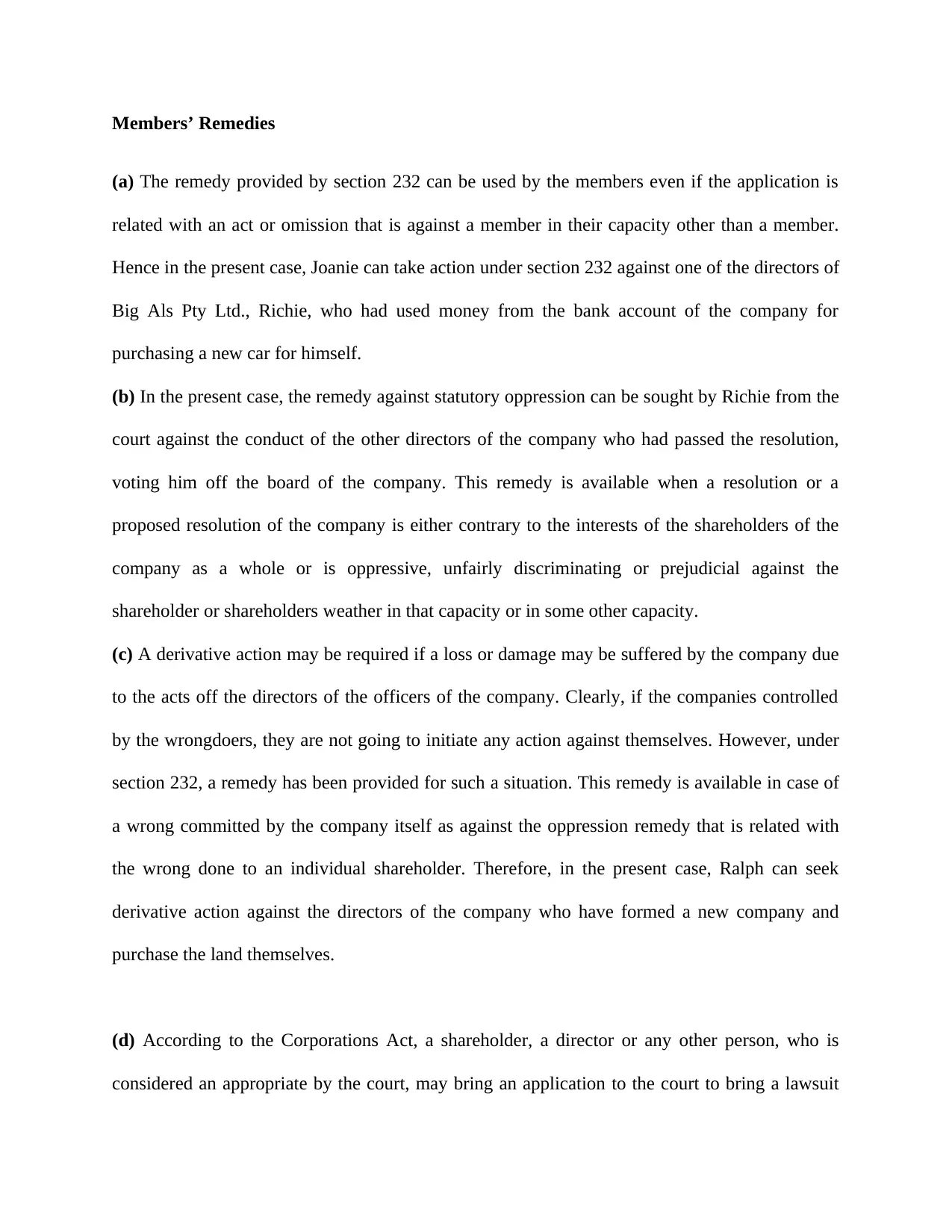
Members’ Remedies
(a) The remedy provided by section 232 can be used by the members even if the application is
related with an act or omission that is against a member in their capacity other than a member.
Hence in the present case, Joanie can take action under section 232 against one of the directors of
Big Als Pty Ltd., Richie, who had used money from the bank account of the company for
purchasing a new car for himself.
(b) In the present case, the remedy against statutory oppression can be sought by Richie from the
court against the conduct of the other directors of the company who had passed the resolution,
voting him off the board of the company. This remedy is available when a resolution or a
proposed resolution of the company is either contrary to the interests of the shareholders of the
company as a whole or is oppressive, unfairly discriminating or prejudicial against the
shareholder or shareholders weather in that capacity or in some other capacity.
(c) A derivative action may be required if a loss or damage may be suffered by the company due
to the acts off the directors of the officers of the company. Clearly, if the companies controlled
by the wrongdoers, they are not going to initiate any action against themselves. However, under
section 232, a remedy has been provided for such a situation. This remedy is available in case of
a wrong committed by the company itself as against the oppression remedy that is related with
the wrong done to an individual shareholder. Therefore, in the present case, Ralph can seek
derivative action against the directors of the company who have formed a new company and
purchase the land themselves.
(d) According to the Corporations Act, a shareholder, a director or any other person, who is
considered an appropriate by the court, may bring an application to the court to bring a lawsuit
(a) The remedy provided by section 232 can be used by the members even if the application is
related with an act or omission that is against a member in their capacity other than a member.
Hence in the present case, Joanie can take action under section 232 against one of the directors of
Big Als Pty Ltd., Richie, who had used money from the bank account of the company for
purchasing a new car for himself.
(b) In the present case, the remedy against statutory oppression can be sought by Richie from the
court against the conduct of the other directors of the company who had passed the resolution,
voting him off the board of the company. This remedy is available when a resolution or a
proposed resolution of the company is either contrary to the interests of the shareholders of the
company as a whole or is oppressive, unfairly discriminating or prejudicial against the
shareholder or shareholders weather in that capacity or in some other capacity.
(c) A derivative action may be required if a loss or damage may be suffered by the company due
to the acts off the directors of the officers of the company. Clearly, if the companies controlled
by the wrongdoers, they are not going to initiate any action against themselves. However, under
section 232, a remedy has been provided for such a situation. This remedy is available in case of
a wrong committed by the company itself as against the oppression remedy that is related with
the wrong done to an individual shareholder. Therefore, in the present case, Ralph can seek
derivative action against the directors of the company who have formed a new company and
purchase the land themselves.
(d) According to the Corporations Act, a shareholder, a director or any other person, who is
considered an appropriate by the court, may bring an application to the court to bring a lawsuit
Paraphrase This Document
Need a fresh take? Get an instant paraphrase of this document with our AI Paraphraser
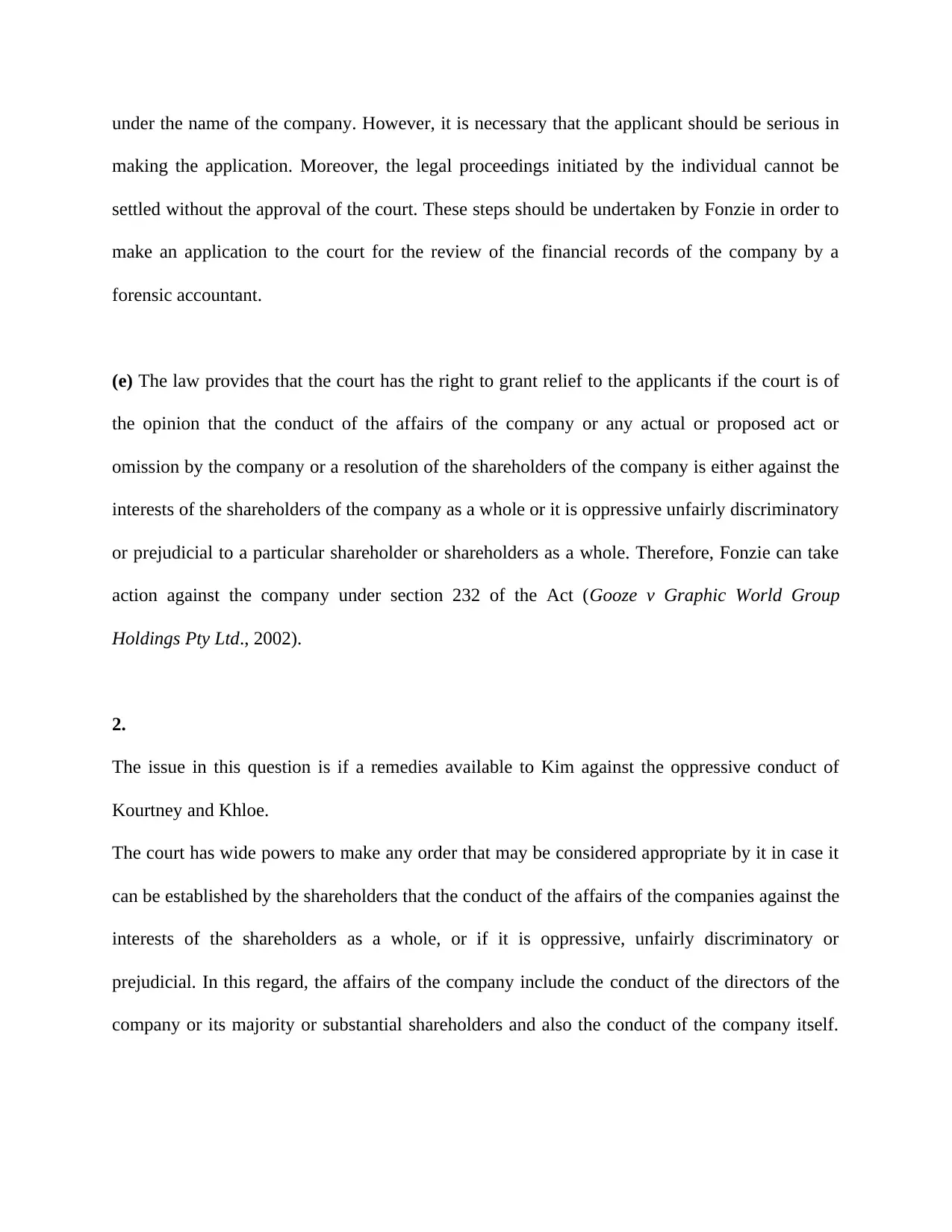
under the name of the company. However, it is necessary that the applicant should be serious in
making the application. Moreover, the legal proceedings initiated by the individual cannot be
settled without the approval of the court. These steps should be undertaken by Fonzie in order to
make an application to the court for the review of the financial records of the company by a
forensic accountant.
(e) The law provides that the court has the right to grant relief to the applicants if the court is of
the opinion that the conduct of the affairs of the company or any actual or proposed act or
omission by the company or a resolution of the shareholders of the company is either against the
interests of the shareholders of the company as a whole or it is oppressive unfairly discriminatory
or prejudicial to a particular shareholder or shareholders as a whole. Therefore, Fonzie can take
action against the company under section 232 of the Act (Gooze v Graphic World Group
Holdings Pty Ltd., 2002).
2.
The issue in this question is if a remedies available to Kim against the oppressive conduct of
Kourtney and Khloe.
The court has wide powers to make any order that may be considered appropriate by it in case it
can be established by the shareholders that the conduct of the affairs of the companies against the
interests of the shareholders as a whole, or if it is oppressive, unfairly discriminatory or
prejudicial. In this regard, the affairs of the company include the conduct of the directors of the
company or its majority or substantial shareholders and also the conduct of the company itself.
making the application. Moreover, the legal proceedings initiated by the individual cannot be
settled without the approval of the court. These steps should be undertaken by Fonzie in order to
make an application to the court for the review of the financial records of the company by a
forensic accountant.
(e) The law provides that the court has the right to grant relief to the applicants if the court is of
the opinion that the conduct of the affairs of the company or any actual or proposed act or
omission by the company or a resolution of the shareholders of the company is either against the
interests of the shareholders of the company as a whole or it is oppressive unfairly discriminatory
or prejudicial to a particular shareholder or shareholders as a whole. Therefore, Fonzie can take
action against the company under section 232 of the Act (Gooze v Graphic World Group
Holdings Pty Ltd., 2002).
2.
The issue in this question is if a remedies available to Kim against the oppressive conduct of
Kourtney and Khloe.
The court has wide powers to make any order that may be considered appropriate by it in case it
can be established by the shareholders that the conduct of the affairs of the companies against the
interests of the shareholders as a whole, or if it is oppressive, unfairly discriminatory or
prejudicial. In this regard, the affairs of the company include the conduct of the directors of the
company or its majority or substantial shareholders and also the conduct of the company itself.
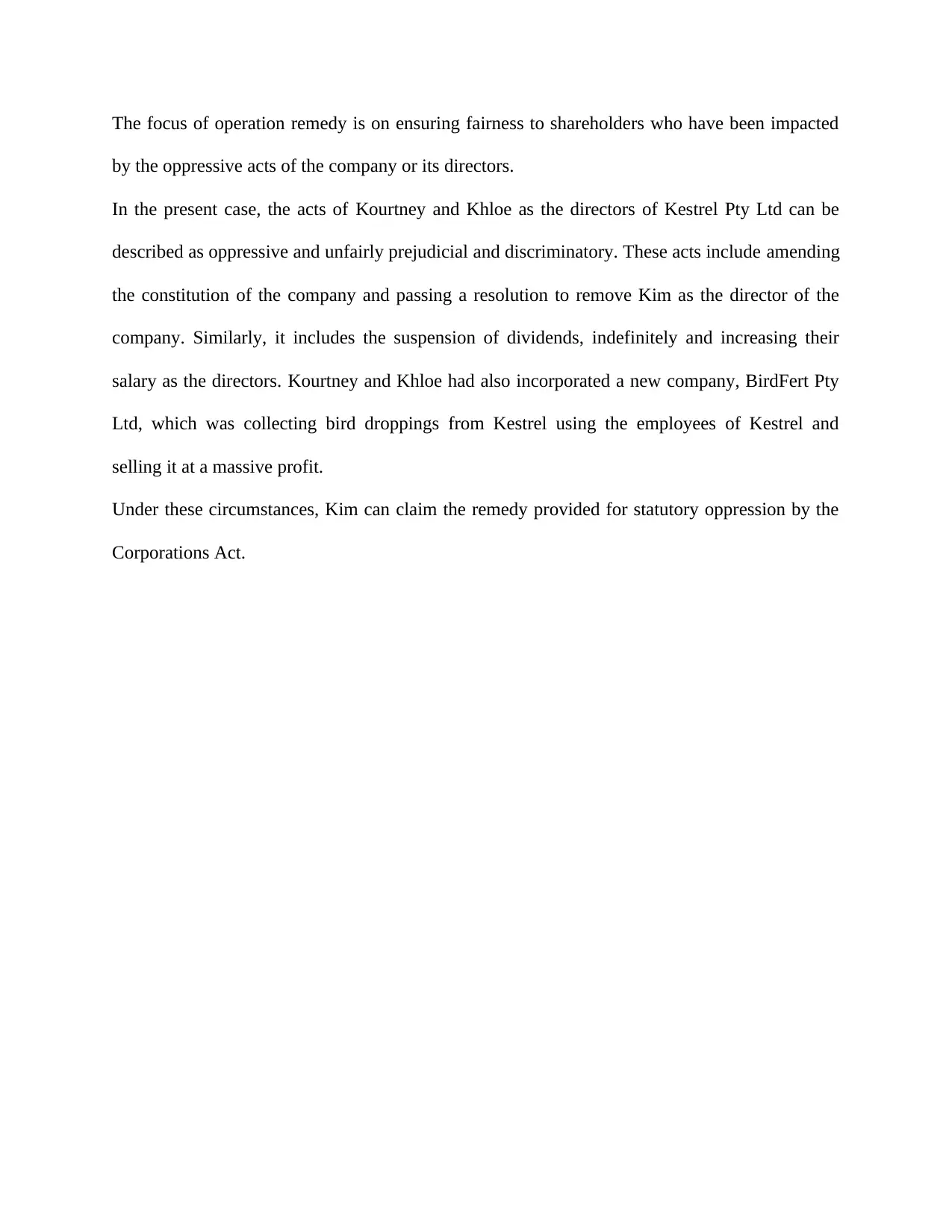
The focus of operation remedy is on ensuring fairness to shareholders who have been impacted
by the oppressive acts of the company or its directors.
In the present case, the acts of Kourtney and Khloe as the directors of Kestrel Pty Ltd can be
described as oppressive and unfairly prejudicial and discriminatory. These acts include amending
the constitution of the company and passing a resolution to remove Kim as the director of the
company. Similarly, it includes the suspension of dividends, indefinitely and increasing their
salary as the directors. Kourtney and Khloe had also incorporated a new company, BirdFert Pty
Ltd, which was collecting bird droppings from Kestrel using the employees of Kestrel and
selling it at a massive profit.
Under these circumstances, Kim can claim the remedy provided for statutory oppression by the
Corporations Act.
by the oppressive acts of the company or its directors.
In the present case, the acts of Kourtney and Khloe as the directors of Kestrel Pty Ltd can be
described as oppressive and unfairly prejudicial and discriminatory. These acts include amending
the constitution of the company and passing a resolution to remove Kim as the director of the
company. Similarly, it includes the suspension of dividends, indefinitely and increasing their
salary as the directors. Kourtney and Khloe had also incorporated a new company, BirdFert Pty
Ltd, which was collecting bird droppings from Kestrel using the employees of Kestrel and
selling it at a massive profit.
Under these circumstances, Kim can claim the remedy provided for statutory oppression by the
Corporations Act.
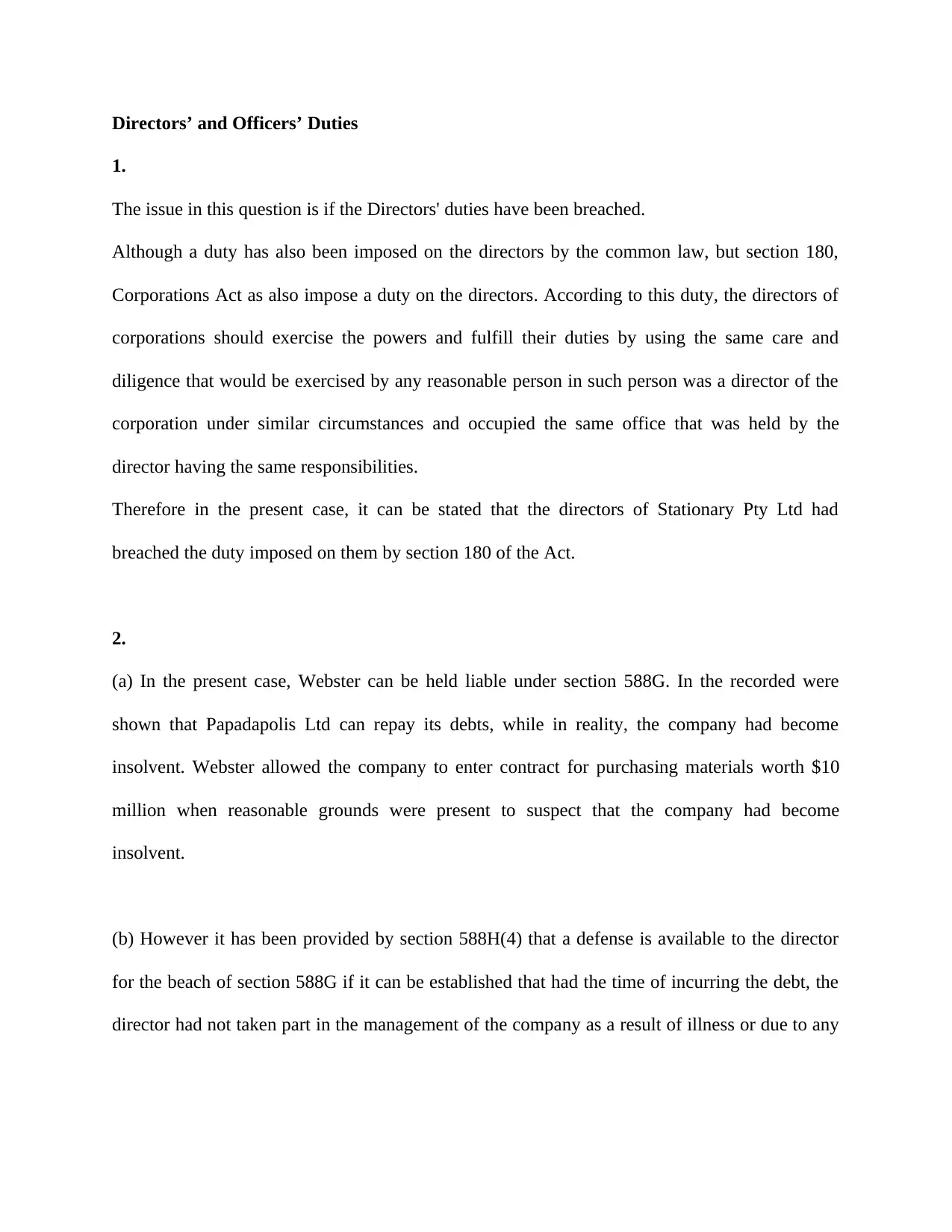
Directors’ and Officers’ Duties
1.
The issue in this question is if the Directors' duties have been breached.
Although a duty has also been imposed on the directors by the common law, but section 180,
Corporations Act as also impose a duty on the directors. According to this duty, the directors of
corporations should exercise the powers and fulfill their duties by using the same care and
diligence that would be exercised by any reasonable person in such person was a director of the
corporation under similar circumstances and occupied the same office that was held by the
director having the same responsibilities.
Therefore in the present case, it can be stated that the directors of Stationary Pty Ltd had
breached the duty imposed on them by section 180 of the Act.
2.
(a) In the present case, Webster can be held liable under section 588G. In the recorded were
shown that Papadapolis Ltd can repay its debts, while in reality, the company had become
insolvent. Webster allowed the company to enter contract for purchasing materials worth $10
million when reasonable grounds were present to suspect that the company had become
insolvent.
(b) However it has been provided by section 588H(4) that a defense is available to the director
for the beach of section 588G if it can be established that had the time of incurring the debt, the
director had not taken part in the management of the company as a result of illness or due to any
1.
The issue in this question is if the Directors' duties have been breached.
Although a duty has also been imposed on the directors by the common law, but section 180,
Corporations Act as also impose a duty on the directors. According to this duty, the directors of
corporations should exercise the powers and fulfill their duties by using the same care and
diligence that would be exercised by any reasonable person in such person was a director of the
corporation under similar circumstances and occupied the same office that was held by the
director having the same responsibilities.
Therefore in the present case, it can be stated that the directors of Stationary Pty Ltd had
breached the duty imposed on them by section 180 of the Act.
2.
(a) In the present case, Webster can be held liable under section 588G. In the recorded were
shown that Papadapolis Ltd can repay its debts, while in reality, the company had become
insolvent. Webster allowed the company to enter contract for purchasing materials worth $10
million when reasonable grounds were present to suspect that the company had become
insolvent.
(b) However it has been provided by section 588H(4) that a defense is available to the director
for the beach of section 588G if it can be established that had the time of incurring the debt, the
director had not taken part in the management of the company as a result of illness or due to any
Secure Best Marks with AI Grader
Need help grading? Try our AI Grader for instant feedback on your assignments.
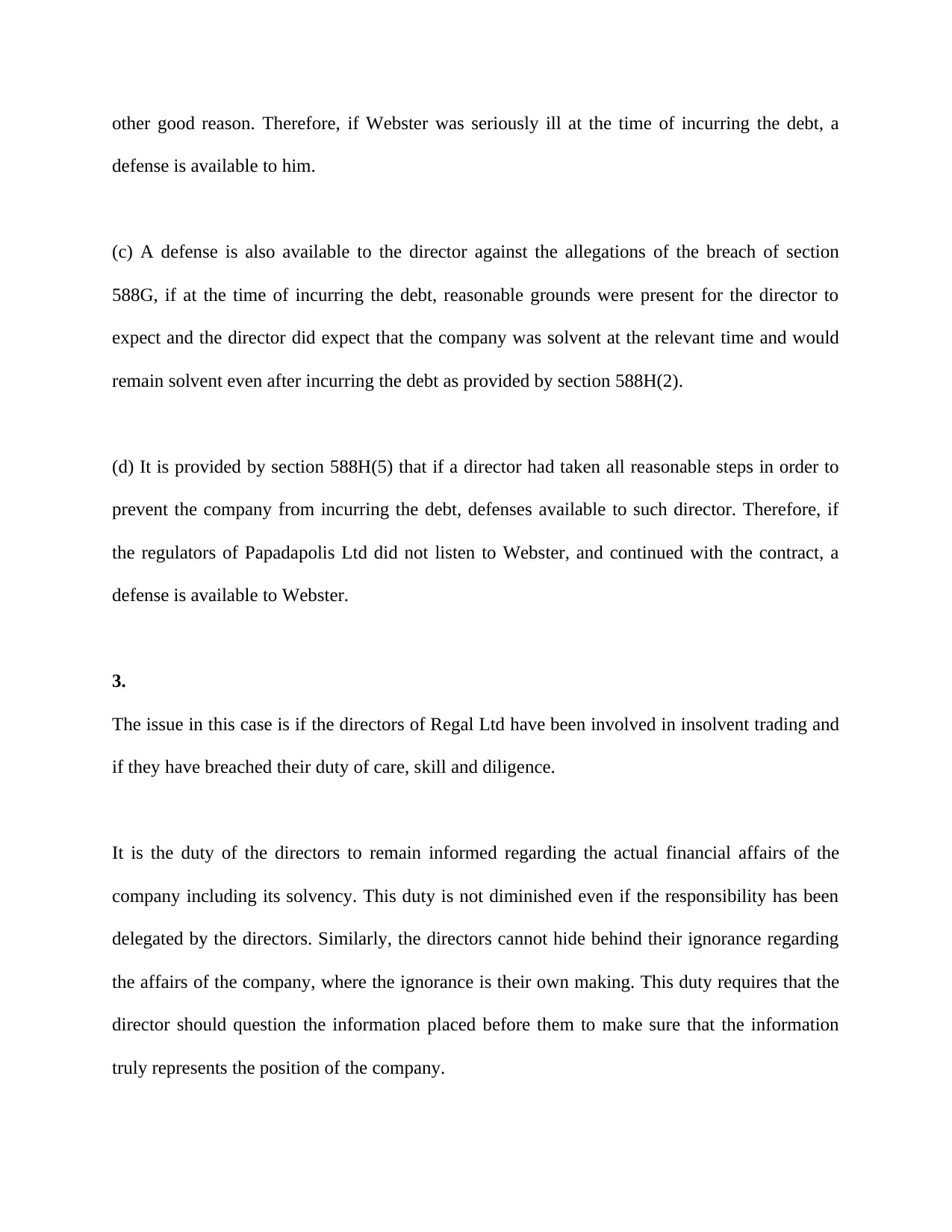
other good reason. Therefore, if Webster was seriously ill at the time of incurring the debt, a
defense is available to him.
(c) A defense is also available to the director against the allegations of the breach of section
588G, if at the time of incurring the debt, reasonable grounds were present for the director to
expect and the director did expect that the company was solvent at the relevant time and would
remain solvent even after incurring the debt as provided by section 588H(2).
(d) It is provided by section 588H(5) that if a director had taken all reasonable steps in order to
prevent the company from incurring the debt, defenses available to such director. Therefore, if
the regulators of Papadapolis Ltd did not listen to Webster, and continued with the contract, a
defense is available to Webster.
3.
The issue in this case is if the directors of Regal Ltd have been involved in insolvent trading and
if they have breached their duty of care, skill and diligence.
It is the duty of the directors to remain informed regarding the actual financial affairs of the
company including its solvency. This duty is not diminished even if the responsibility has been
delegated by the directors. Similarly, the directors cannot hide behind their ignorance regarding
the affairs of the company, where the ignorance is their own making. This duty requires that the
director should question the information placed before them to make sure that the information
truly represents the position of the company.
defense is available to him.
(c) A defense is also available to the director against the allegations of the breach of section
588G, if at the time of incurring the debt, reasonable grounds were present for the director to
expect and the director did expect that the company was solvent at the relevant time and would
remain solvent even after incurring the debt as provided by section 588H(2).
(d) It is provided by section 588H(5) that if a director had taken all reasonable steps in order to
prevent the company from incurring the debt, defenses available to such director. Therefore, if
the regulators of Papadapolis Ltd did not listen to Webster, and continued with the contract, a
defense is available to Webster.
3.
The issue in this case is if the directors of Regal Ltd have been involved in insolvent trading and
if they have breached their duty of care, skill and diligence.
It is the duty of the directors to remain informed regarding the actual financial affairs of the
company including its solvency. This duty is not diminished even if the responsibility has been
delegated by the directors. Similarly, the directors cannot hide behind their ignorance regarding
the affairs of the company, where the ignorance is their own making. This duty requires that the
director should question the information placed before them to make sure that the information
truly represents the position of the company.
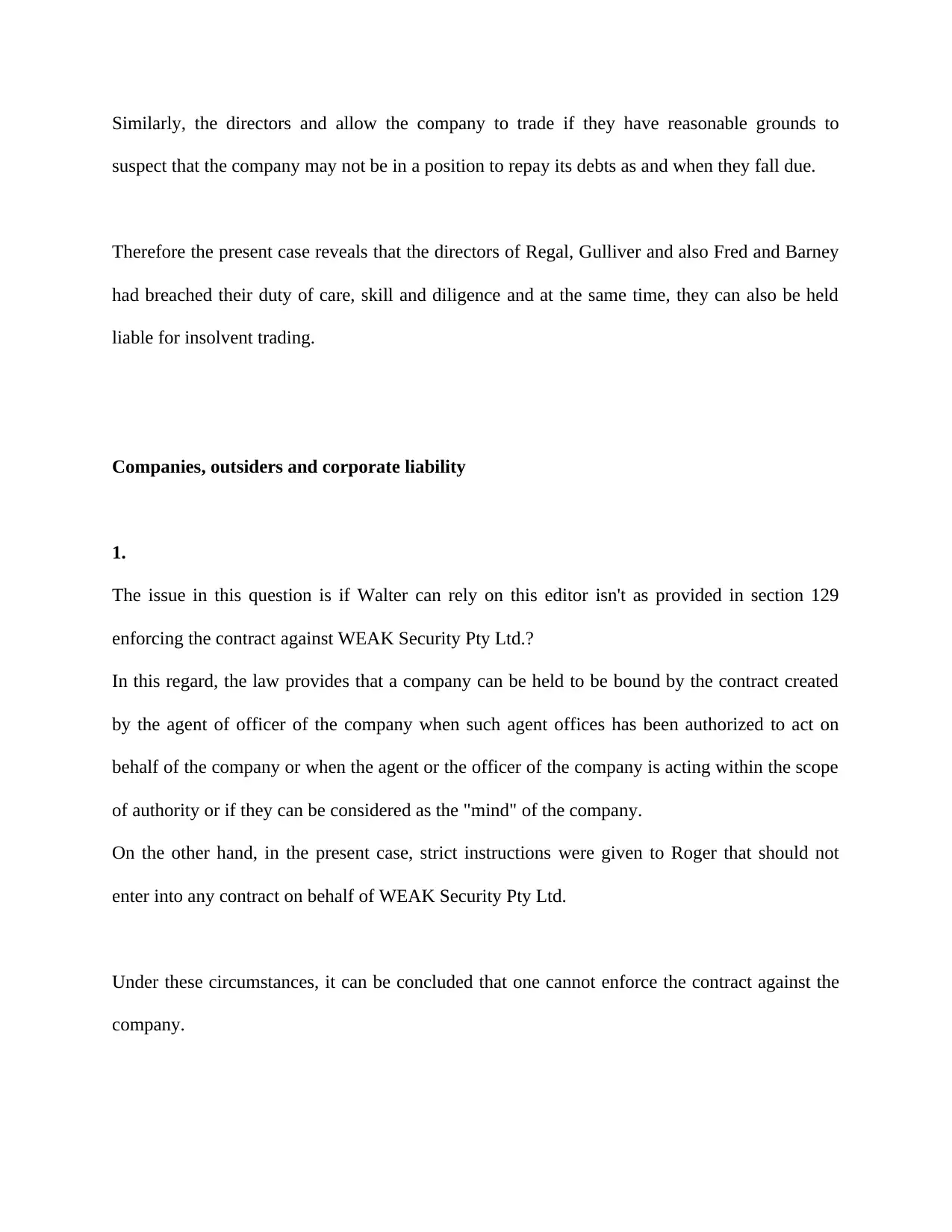
Similarly, the directors and allow the company to trade if they have reasonable grounds to
suspect that the company may not be in a position to repay its debts as and when they fall due.
Therefore the present case reveals that the directors of Regal, Gulliver and also Fred and Barney
had breached their duty of care, skill and diligence and at the same time, they can also be held
liable for insolvent trading.
Companies, outsiders and corporate liability
1.
The issue in this question is if Walter can rely on this editor isn't as provided in section 129
enforcing the contract against WEAK Security Pty Ltd.?
In this regard, the law provides that a company can be held to be bound by the contract created
by the agent of officer of the company when such agent offices has been authorized to act on
behalf of the company or when the agent or the officer of the company is acting within the scope
of authority or if they can be considered as the "mind" of the company.
On the other hand, in the present case, strict instructions were given to Roger that should not
enter into any contract on behalf of WEAK Security Pty Ltd.
Under these circumstances, it can be concluded that one cannot enforce the contract against the
company.
suspect that the company may not be in a position to repay its debts as and when they fall due.
Therefore the present case reveals that the directors of Regal, Gulliver and also Fred and Barney
had breached their duty of care, skill and diligence and at the same time, they can also be held
liable for insolvent trading.
Companies, outsiders and corporate liability
1.
The issue in this question is if Walter can rely on this editor isn't as provided in section 129
enforcing the contract against WEAK Security Pty Ltd.?
In this regard, the law provides that a company can be held to be bound by the contract created
by the agent of officer of the company when such agent offices has been authorized to act on
behalf of the company or when the agent or the officer of the company is acting within the scope
of authority or if they can be considered as the "mind" of the company.
On the other hand, in the present case, strict instructions were given to Roger that should not
enter into any contract on behalf of WEAK Security Pty Ltd.
Under these circumstances, it can be concluded that one cannot enforce the contract against the
company.
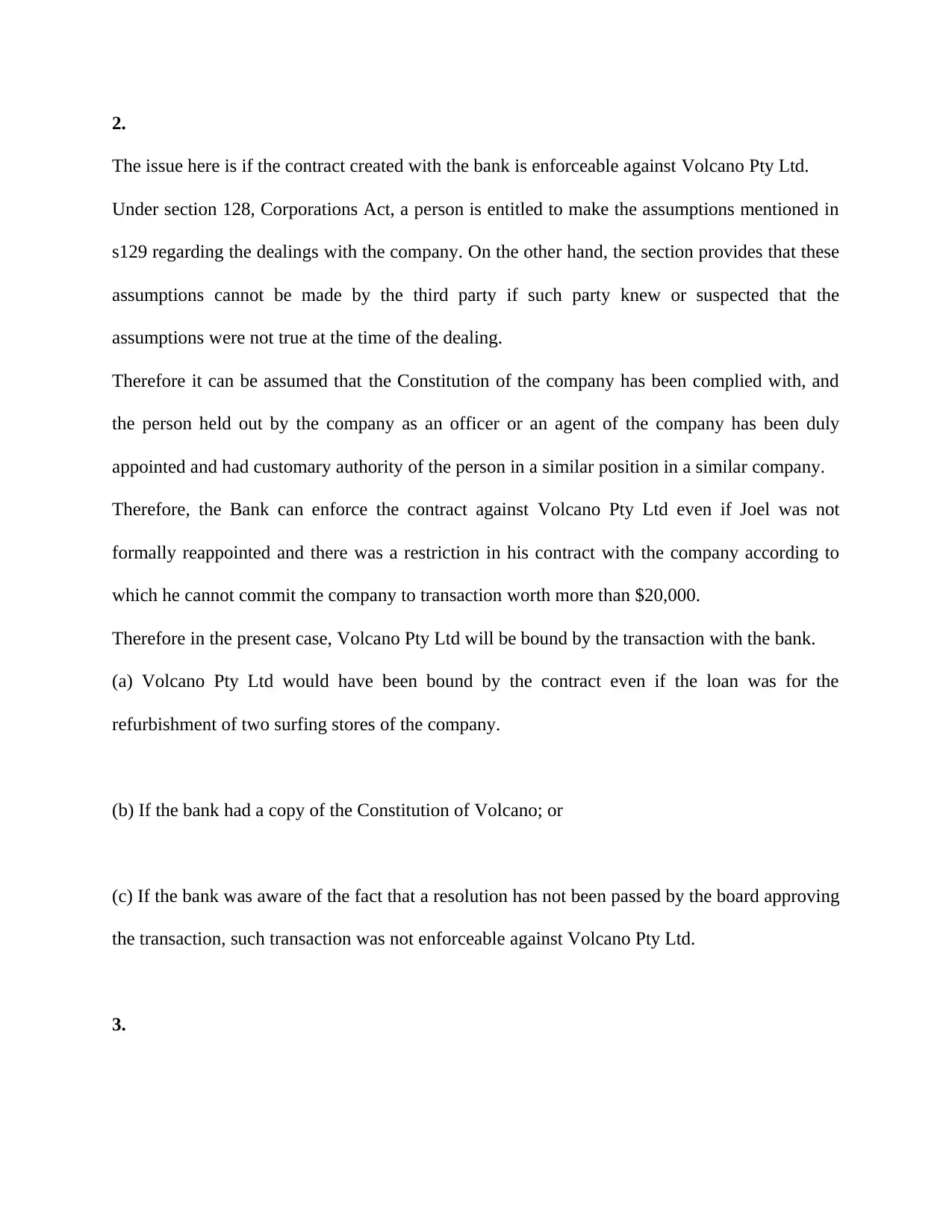
2.
The issue here is if the contract created with the bank is enforceable against Volcano Pty Ltd.
Under section 128, Corporations Act, a person is entitled to make the assumptions mentioned in
s129 regarding the dealings with the company. On the other hand, the section provides that these
assumptions cannot be made by the third party if such party knew or suspected that the
assumptions were not true at the time of the dealing.
Therefore it can be assumed that the Constitution of the company has been complied with, and
the person held out by the company as an officer or an agent of the company has been duly
appointed and had customary authority of the person in a similar position in a similar company.
Therefore, the Bank can enforce the contract against Volcano Pty Ltd even if Joel was not
formally reappointed and there was a restriction in his contract with the company according to
which he cannot commit the company to transaction worth more than $20,000.
Therefore in the present case, Volcano Pty Ltd will be bound by the transaction with the bank.
(a) Volcano Pty Ltd would have been bound by the contract even if the loan was for the
refurbishment of two surfing stores of the company.
(b) If the bank had a copy of the Constitution of Volcano; or
(c) If the bank was aware of the fact that a resolution has not been passed by the board approving
the transaction, such transaction was not enforceable against Volcano Pty Ltd.
3.
The issue here is if the contract created with the bank is enforceable against Volcano Pty Ltd.
Under section 128, Corporations Act, a person is entitled to make the assumptions mentioned in
s129 regarding the dealings with the company. On the other hand, the section provides that these
assumptions cannot be made by the third party if such party knew or suspected that the
assumptions were not true at the time of the dealing.
Therefore it can be assumed that the Constitution of the company has been complied with, and
the person held out by the company as an officer or an agent of the company has been duly
appointed and had customary authority of the person in a similar position in a similar company.
Therefore, the Bank can enforce the contract against Volcano Pty Ltd even if Joel was not
formally reappointed and there was a restriction in his contract with the company according to
which he cannot commit the company to transaction worth more than $20,000.
Therefore in the present case, Volcano Pty Ltd will be bound by the transaction with the bank.
(a) Volcano Pty Ltd would have been bound by the contract even if the loan was for the
refurbishment of two surfing stores of the company.
(b) If the bank had a copy of the Constitution of Volcano; or
(c) If the bank was aware of the fact that a resolution has not been passed by the board approving
the transaction, such transaction was not enforceable against Volcano Pty Ltd.
3.
Paraphrase This Document
Need a fresh take? Get an instant paraphrase of this document with our AI Paraphraser
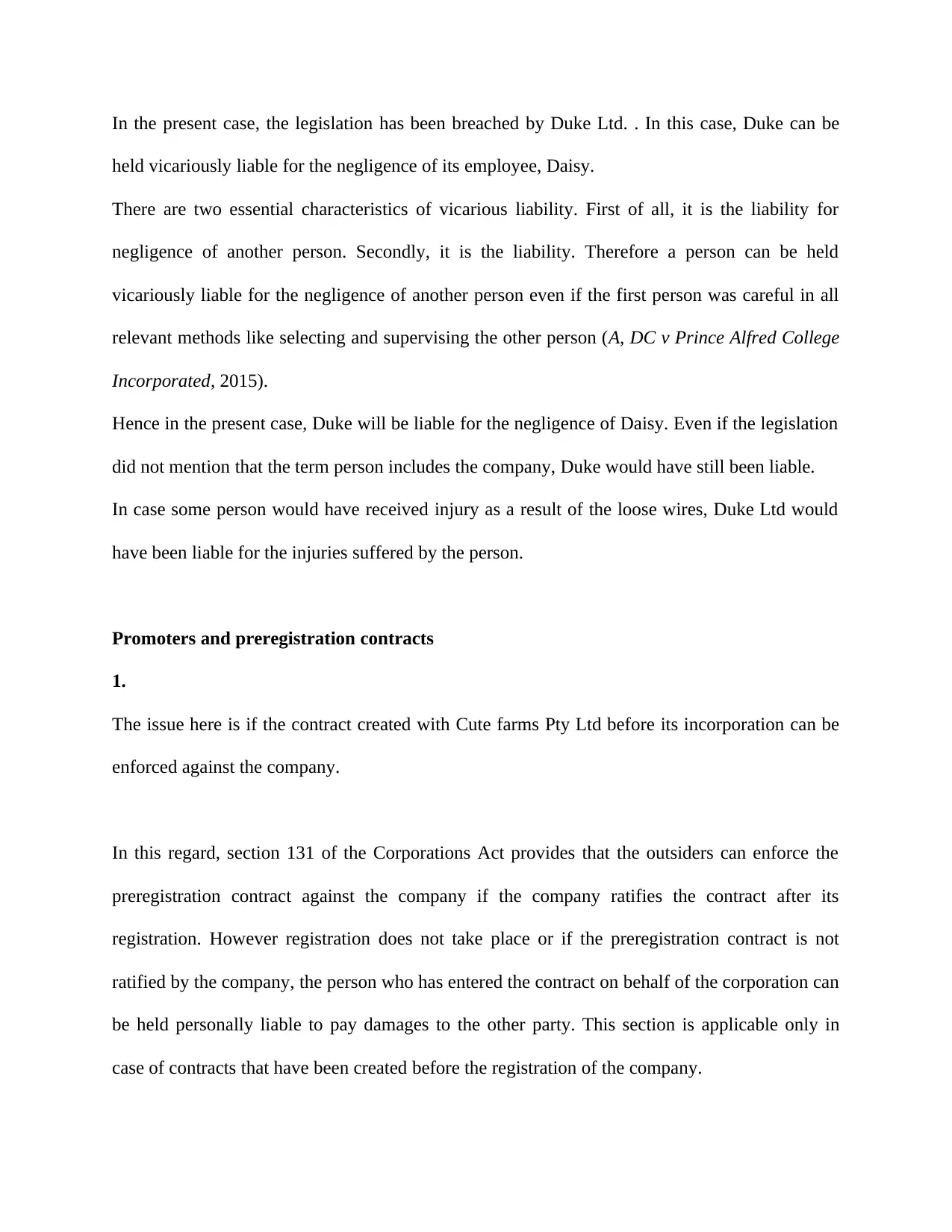
In the present case, the legislation has been breached by Duke Ltd. . In this case, Duke can be
held vicariously liable for the negligence of its employee, Daisy.
There are two essential characteristics of vicarious liability. First of all, it is the liability for
negligence of another person. Secondly, it is the liability. Therefore a person can be held
vicariously liable for the negligence of another person even if the first person was careful in all
relevant methods like selecting and supervising the other person (A, DC v Prince Alfred College
Incorporated, 2015).
Hence in the present case, Duke will be liable for the negligence of Daisy. Even if the legislation
did not mention that the term person includes the company, Duke would have still been liable.
In case some person would have received injury as a result of the loose wires, Duke Ltd would
have been liable for the injuries suffered by the person.
Promoters and preregistration contracts
1.
The issue here is if the contract created with Cute farms Pty Ltd before its incorporation can be
enforced against the company.
In this regard, section 131 of the Corporations Act provides that the outsiders can enforce the
preregistration contract against the company if the company ratifies the contract after its
registration. However registration does not take place or if the preregistration contract is not
ratified by the company, the person who has entered the contract on behalf of the corporation can
be held personally liable to pay damages to the other party. This section is applicable only in
case of contracts that have been created before the registration of the company.
held vicariously liable for the negligence of its employee, Daisy.
There are two essential characteristics of vicarious liability. First of all, it is the liability for
negligence of another person. Secondly, it is the liability. Therefore a person can be held
vicariously liable for the negligence of another person even if the first person was careful in all
relevant methods like selecting and supervising the other person (A, DC v Prince Alfred College
Incorporated, 2015).
Hence in the present case, Duke will be liable for the negligence of Daisy. Even if the legislation
did not mention that the term person includes the company, Duke would have still been liable.
In case some person would have received injury as a result of the loose wires, Duke Ltd would
have been liable for the injuries suffered by the person.
Promoters and preregistration contracts
1.
The issue here is if the contract created with Cute farms Pty Ltd before its incorporation can be
enforced against the company.
In this regard, section 131 of the Corporations Act provides that the outsiders can enforce the
preregistration contract against the company if the company ratifies the contract after its
registration. However registration does not take place or if the preregistration contract is not
ratified by the company, the person who has entered the contract on behalf of the corporation can
be held personally liable to pay damages to the other party. This section is applicable only in
case of contracts that have been created before the registration of the company.
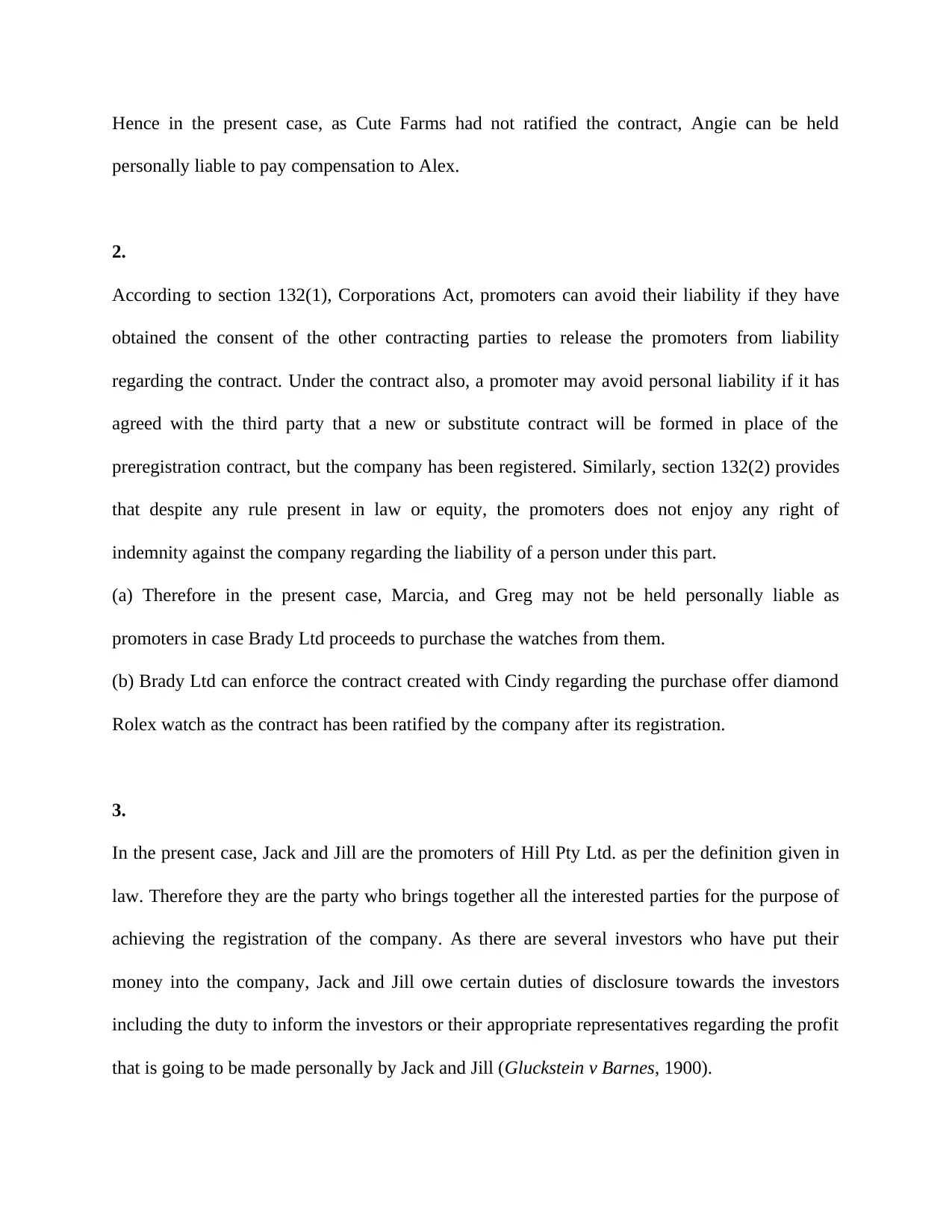
Hence in the present case, as Cute Farms had not ratified the contract, Angie can be held
personally liable to pay compensation to Alex.
2.
According to section 132(1), Corporations Act, promoters can avoid their liability if they have
obtained the consent of the other contracting parties to release the promoters from liability
regarding the contract. Under the contract also, a promoter may avoid personal liability if it has
agreed with the third party that a new or substitute contract will be formed in place of the
preregistration contract, but the company has been registered. Similarly, section 132(2) provides
that despite any rule present in law or equity, the promoters does not enjoy any right of
indemnity against the company regarding the liability of a person under this part.
(a) Therefore in the present case, Marcia, and Greg may not be held personally liable as
promoters in case Brady Ltd proceeds to purchase the watches from them.
(b) Brady Ltd can enforce the contract created with Cindy regarding the purchase offer diamond
Rolex watch as the contract has been ratified by the company after its registration.
3.
In the present case, Jack and Jill are the promoters of Hill Pty Ltd. as per the definition given in
law. Therefore they are the party who brings together all the interested parties for the purpose of
achieving the registration of the company. As there are several investors who have put their
money into the company, Jack and Jill owe certain duties of disclosure towards the investors
including the duty to inform the investors or their appropriate representatives regarding the profit
that is going to be made personally by Jack and Jill (Gluckstein v Barnes, 1900).
personally liable to pay compensation to Alex.
2.
According to section 132(1), Corporations Act, promoters can avoid their liability if they have
obtained the consent of the other contracting parties to release the promoters from liability
regarding the contract. Under the contract also, a promoter may avoid personal liability if it has
agreed with the third party that a new or substitute contract will be formed in place of the
preregistration contract, but the company has been registered. Similarly, section 132(2) provides
that despite any rule present in law or equity, the promoters does not enjoy any right of
indemnity against the company regarding the liability of a person under this part.
(a) Therefore in the present case, Marcia, and Greg may not be held personally liable as
promoters in case Brady Ltd proceeds to purchase the watches from them.
(b) Brady Ltd can enforce the contract created with Cindy regarding the purchase offer diamond
Rolex watch as the contract has been ratified by the company after its registration.
3.
In the present case, Jack and Jill are the promoters of Hill Pty Ltd. as per the definition given in
law. Therefore they are the party who brings together all the interested parties for the purpose of
achieving the registration of the company. As there are several investors who have put their
money into the company, Jack and Jill owe certain duties of disclosure towards the investors
including the duty to inform the investors or their appropriate representatives regarding the profit
that is going to be made personally by Jack and Jill (Gluckstein v Barnes, 1900).
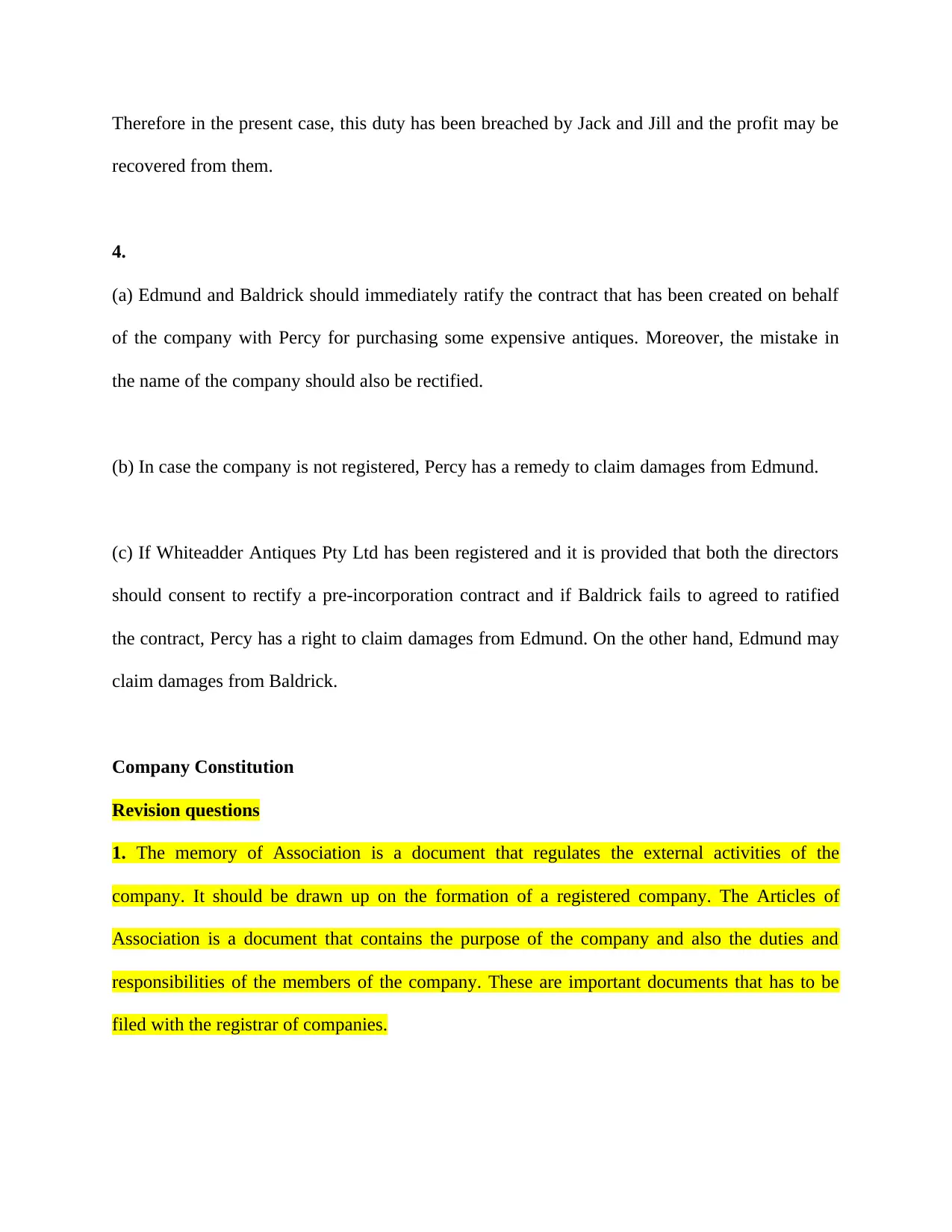
Therefore in the present case, this duty has been breached by Jack and Jill and the profit may be
recovered from them.
4.
(a) Edmund and Baldrick should immediately ratify the contract that has been created on behalf
of the company with Percy for purchasing some expensive antiques. Moreover, the mistake in
the name of the company should also be rectified.
(b) In case the company is not registered, Percy has a remedy to claim damages from Edmund.
(c) If Whiteadder Antiques Pty Ltd has been registered and it is provided that both the directors
should consent to rectify a pre-incorporation contract and if Baldrick fails to agreed to ratified
the contract, Percy has a right to claim damages from Edmund. On the other hand, Edmund may
claim damages from Baldrick.
Company Constitution
Revision questions
1. The memory of Association is a document that regulates the external activities of the
company. It should be drawn up on the formation of a registered company. The Articles of
Association is a document that contains the purpose of the company and also the duties and
responsibilities of the members of the company. These are important documents that has to be
filed with the registrar of companies.
recovered from them.
4.
(a) Edmund and Baldrick should immediately ratify the contract that has been created on behalf
of the company with Percy for purchasing some expensive antiques. Moreover, the mistake in
the name of the company should also be rectified.
(b) In case the company is not registered, Percy has a remedy to claim damages from Edmund.
(c) If Whiteadder Antiques Pty Ltd has been registered and it is provided that both the directors
should consent to rectify a pre-incorporation contract and if Baldrick fails to agreed to ratified
the contract, Percy has a right to claim damages from Edmund. On the other hand, Edmund may
claim damages from Baldrick.
Company Constitution
Revision questions
1. The memory of Association is a document that regulates the external activities of the
company. It should be drawn up on the formation of a registered company. The Articles of
Association is a document that contains the purpose of the company and also the duties and
responsibilities of the members of the company. These are important documents that has to be
filed with the registrar of companies.
Secure Best Marks with AI Grader
Need help grading? Try our AI Grader for instant feedback on your assignments.

2. A replaceable rule is a provision of this section or subsection of the Corporations Act that can
be displaced or modified by the Constitution of the company. The provisions of the Corporations
Act applying as replaceable roles had been mentioned in section 141 of the Act.
3. A Company Constitution is a document that generally specifies the rules governing the
relationship between and activities of the company, its directors and shareholders. The
Constitution may modify the provisions of the corporations act that apply as replaceable rules.
4. The internal management of a company may be governed by the provisions of the corporations
act known as replaceable rules, by a Constitution or by a combination of both. A Constitution is
a contract created between company and its members, directors and the members themselves.
5. A company can change or repeal its constitution by passing a special resolution. The special
resolution needs at least 28 days notice engage the public listed companies and 21 days notice
engage off other types of companies.
Problem questions
1.
The Constitution of the company is considered as a contract that has been created between the
company and the members of the company. Therefore in the present case, Jack cannot enforce
the Constitution of Nightclub Pty Ltd and argued that the exclusion is not enforceable because it
is not supported by a resolution passed by the directors.
2.
be displaced or modified by the Constitution of the company. The provisions of the Corporations
Act applying as replaceable roles had been mentioned in section 141 of the Act.
3. A Company Constitution is a document that generally specifies the rules governing the
relationship between and activities of the company, its directors and shareholders. The
Constitution may modify the provisions of the corporations act that apply as replaceable rules.
4. The internal management of a company may be governed by the provisions of the corporations
act known as replaceable rules, by a Constitution or by a combination of both. A Constitution is
a contract created between company and its members, directors and the members themselves.
5. A company can change or repeal its constitution by passing a special resolution. The special
resolution needs at least 28 days notice engage the public listed companies and 21 days notice
engage off other types of companies.
Problem questions
1.
The Constitution of the company is considered as a contract that has been created between the
company and the members of the company. Therefore in the present case, Jack cannot enforce
the Constitution of Nightclub Pty Ltd and argued that the exclusion is not enforceable because it
is not supported by a resolution passed by the directors.
2.
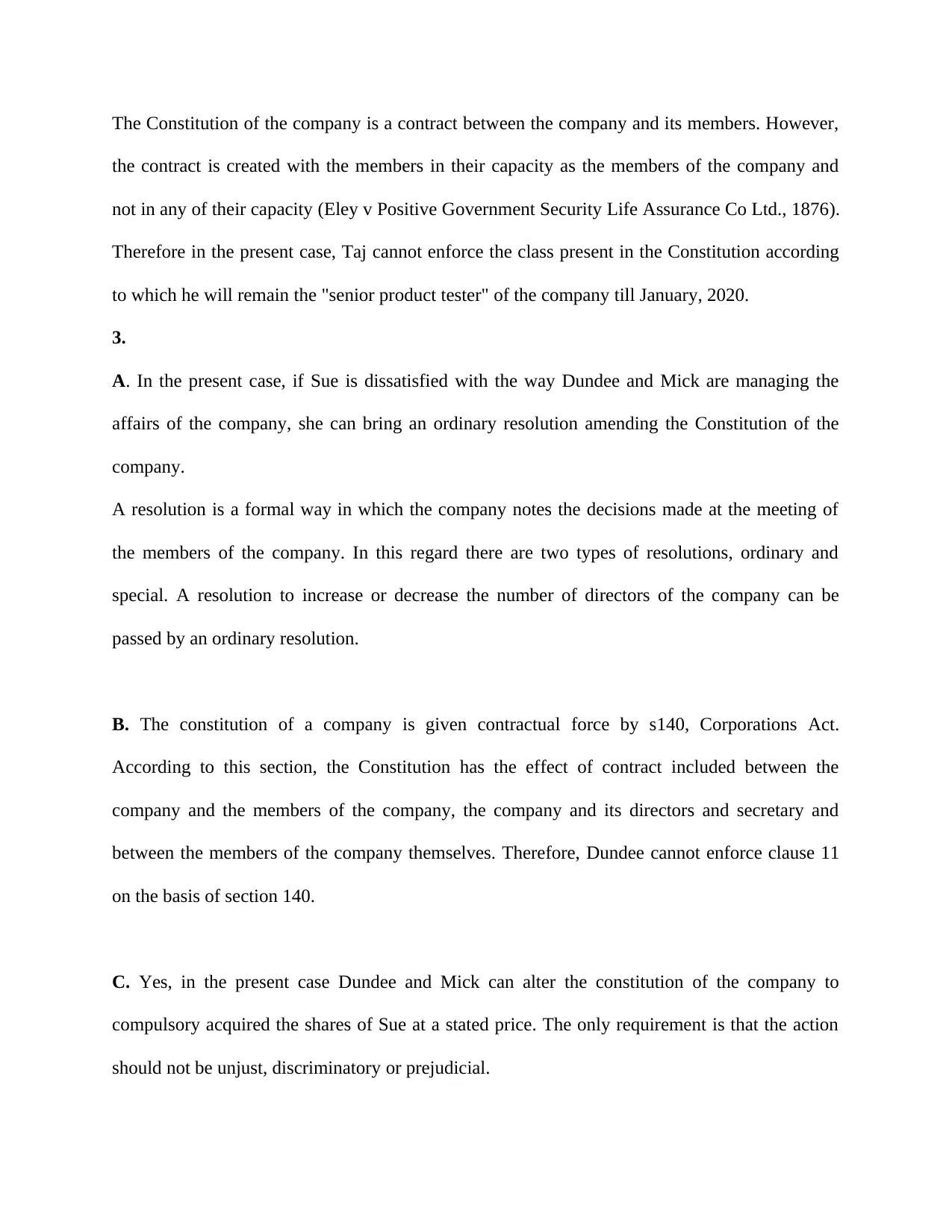
The Constitution of the company is a contract between the company and its members. However,
the contract is created with the members in their capacity as the members of the company and
not in any of their capacity (Eley v Positive Government Security Life Assurance Co Ltd., 1876).
Therefore in the present case, Taj cannot enforce the class present in the Constitution according
to which he will remain the "senior product tester" of the company till January, 2020.
3.
A. In the present case, if Sue is dissatisfied with the way Dundee and Mick are managing the
affairs of the company, she can bring an ordinary resolution amending the Constitution of the
company.
A resolution is a formal way in which the company notes the decisions made at the meeting of
the members of the company. In this regard there are two types of resolutions, ordinary and
special. A resolution to increase or decrease the number of directors of the company can be
passed by an ordinary resolution.
B. The constitution of a company is given contractual force by s140, Corporations Act.
According to this section, the Constitution has the effect of contract included between the
company and the members of the company, the company and its directors and secretary and
between the members of the company themselves. Therefore, Dundee cannot enforce clause 11
on the basis of section 140.
C. Yes, in the present case Dundee and Mick can alter the constitution of the company to
compulsory acquired the shares of Sue at a stated price. The only requirement is that the action
should not be unjust, discriminatory or prejudicial.
the contract is created with the members in their capacity as the members of the company and
not in any of their capacity (Eley v Positive Government Security Life Assurance Co Ltd., 1876).
Therefore in the present case, Taj cannot enforce the class present in the Constitution according
to which he will remain the "senior product tester" of the company till January, 2020.
3.
A. In the present case, if Sue is dissatisfied with the way Dundee and Mick are managing the
affairs of the company, she can bring an ordinary resolution amending the Constitution of the
company.
A resolution is a formal way in which the company notes the decisions made at the meeting of
the members of the company. In this regard there are two types of resolutions, ordinary and
special. A resolution to increase or decrease the number of directors of the company can be
passed by an ordinary resolution.
B. The constitution of a company is given contractual force by s140, Corporations Act.
According to this section, the Constitution has the effect of contract included between the
company and the members of the company, the company and its directors and secretary and
between the members of the company themselves. Therefore, Dundee cannot enforce clause 11
on the basis of section 140.
C. Yes, in the present case Dundee and Mick can alter the constitution of the company to
compulsory acquired the shares of Sue at a stated price. The only requirement is that the action
should not be unjust, discriminatory or prejudicial.

D. The alteration in the Constitution of the company which provides that the shareholders cannot
sell their shares to a person who is in combination with the company can be enforced against the
shareholders.
4. In order to remove Kenny from the position of the CFO of the company, Kitty, Butch and
Leroy are required to pass an ordinary resolution in the meeting of the members of the company.
On the other hand, if the company wants to engage in a business other than dog grooming, the
members of the company are required to pass a special resolution.
5. Section 136(1), Corporations Act outlines the ways in which a constitution can be adopted by
a company. A constitution may be adopted by the company on its registration, if each person
mentioned in the company has agreed in writing, to the terms of the Constitution or if a company
is registered with the Constitution, but it may adopt a constitution by passing a special resolution.
Companies and incorporation
Problem questions
6. There are two major types of companies in Australia. These are private (proprietary) and
public companies. The most common type of company formed in Australia is to provide the
company. This type of company is signified by 'Pty' at the end of the name of the company. In
the present case, Bobby should form a proprietary company.
sell their shares to a person who is in combination with the company can be enforced against the
shareholders.
4. In order to remove Kenny from the position of the CFO of the company, Kitty, Butch and
Leroy are required to pass an ordinary resolution in the meeting of the members of the company.
On the other hand, if the company wants to engage in a business other than dog grooming, the
members of the company are required to pass a special resolution.
5. Section 136(1), Corporations Act outlines the ways in which a constitution can be adopted by
a company. A constitution may be adopted by the company on its registration, if each person
mentioned in the company has agreed in writing, to the terms of the Constitution or if a company
is registered with the Constitution, but it may adopt a constitution by passing a special resolution.
Companies and incorporation
Problem questions
6. There are two major types of companies in Australia. These are private (proprietary) and
public companies. The most common type of company formed in Australia is to provide the
company. This type of company is signified by 'Pty' at the end of the name of the company. In
the present case, Bobby should form a proprietary company.
Paraphrase This Document
Need a fresh take? Get an instant paraphrase of this document with our AI Paraphraser
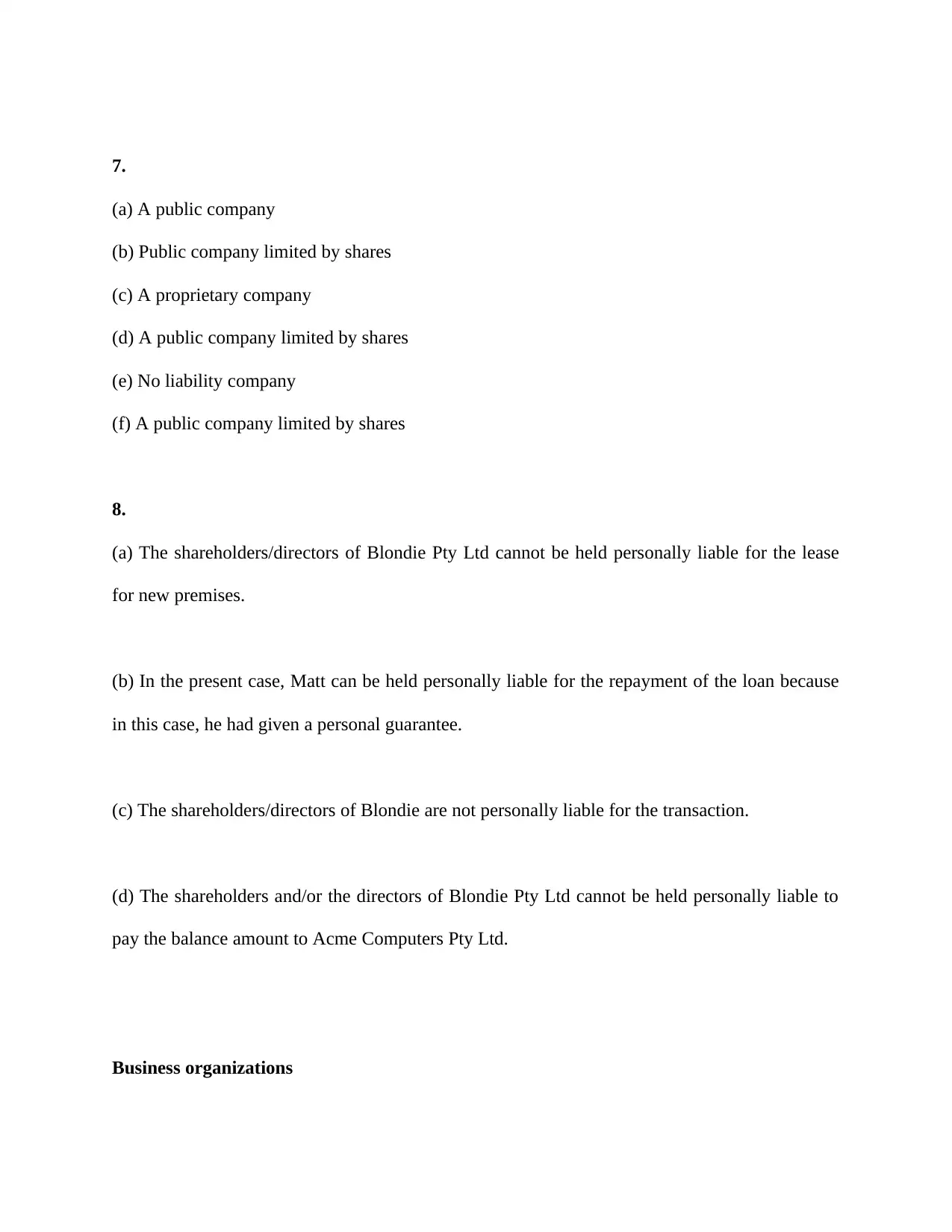
7.
(a) A public company
(b) Public company limited by shares
(c) A proprietary company
(d) A public company limited by shares
(e) No liability company
(f) A public company limited by shares
8.
(a) The shareholders/directors of Blondie Pty Ltd cannot be held personally liable for the lease
for new premises.
(b) In the present case, Matt can be held personally liable for the repayment of the loan because
in this case, he had given a personal guarantee.
(c) The shareholders/directors of Blondie are not personally liable for the transaction.
(d) The shareholders and/or the directors of Blondie Pty Ltd cannot be held personally liable to
pay the balance amount to Acme Computers Pty Ltd.
Business organizations
(a) A public company
(b) Public company limited by shares
(c) A proprietary company
(d) A public company limited by shares
(e) No liability company
(f) A public company limited by shares
8.
(a) The shareholders/directors of Blondie Pty Ltd cannot be held personally liable for the lease
for new premises.
(b) In the present case, Matt can be held personally liable for the repayment of the loan because
in this case, he had given a personal guarantee.
(c) The shareholders/directors of Blondie are not personally liable for the transaction.
(d) The shareholders and/or the directors of Blondie Pty Ltd cannot be held personally liable to
pay the balance amount to Acme Computers Pty Ltd.
Business organizations
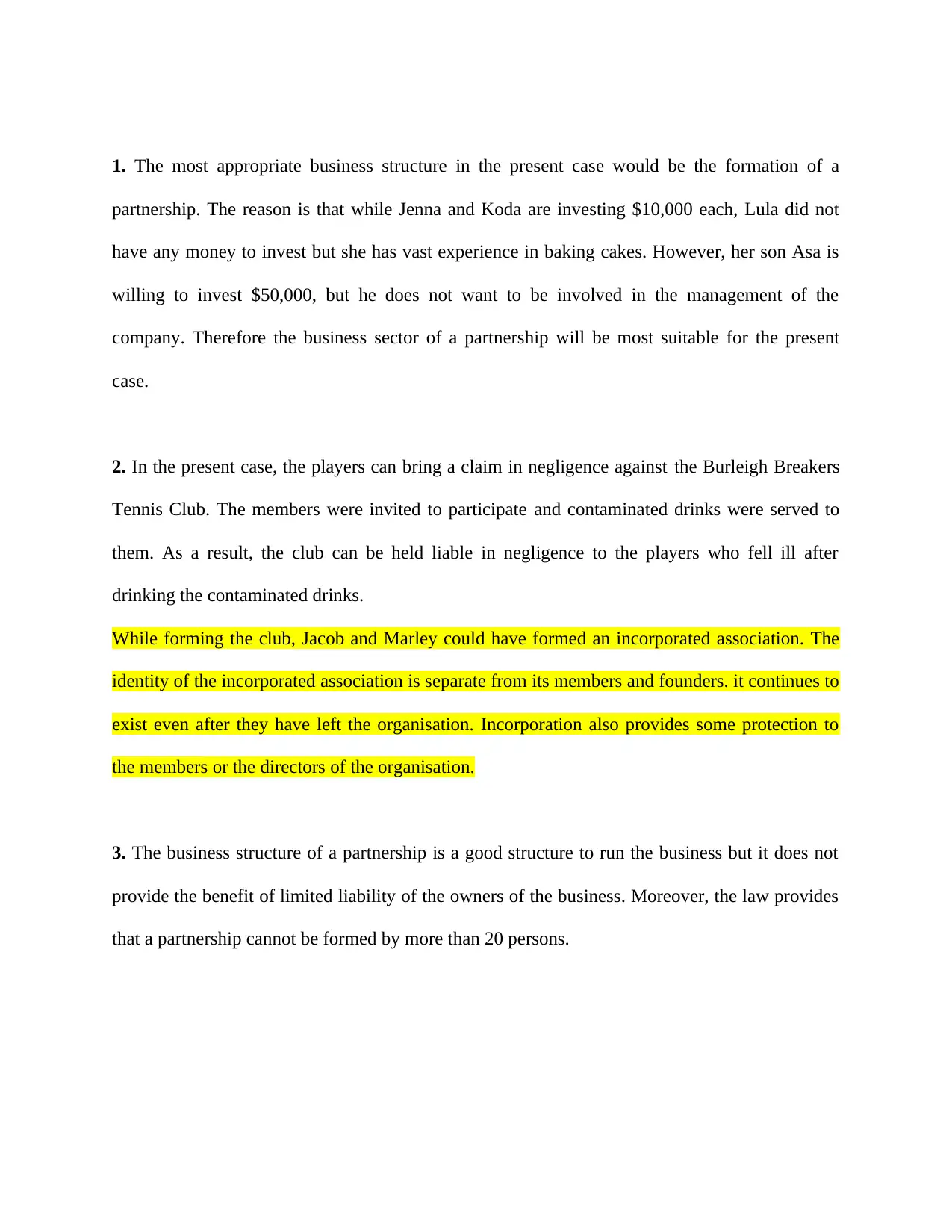
1. The most appropriate business structure in the present case would be the formation of a
partnership. The reason is that while Jenna and Koda are investing $10,000 each, Lula did not
have any money to invest but she has vast experience in baking cakes. However, her son Asa is
willing to invest $50,000, but he does not want to be involved in the management of the
company. Therefore the business sector of a partnership will be most suitable for the present
case.
2. In the present case, the players can bring a claim in negligence against the Burleigh Breakers
Tennis Club. The members were invited to participate and contaminated drinks were served to
them. As a result, the club can be held liable in negligence to the players who fell ill after
drinking the contaminated drinks.
While forming the club, Jacob and Marley could have formed an incorporated association. The
identity of the incorporated association is separate from its members and founders. it continues to
exist even after they have left the organisation. Incorporation also provides some protection to
the members or the directors of the organisation.
3. The business structure of a partnership is a good structure to run the business but it does not
provide the benefit of limited liability of the owners of the business. Moreover, the law provides
that a partnership cannot be formed by more than 20 persons.
partnership. The reason is that while Jenna and Koda are investing $10,000 each, Lula did not
have any money to invest but she has vast experience in baking cakes. However, her son Asa is
willing to invest $50,000, but he does not want to be involved in the management of the
company. Therefore the business sector of a partnership will be most suitable for the present
case.
2. In the present case, the players can bring a claim in negligence against the Burleigh Breakers
Tennis Club. The members were invited to participate and contaminated drinks were served to
them. As a result, the club can be held liable in negligence to the players who fell ill after
drinking the contaminated drinks.
While forming the club, Jacob and Marley could have formed an incorporated association. The
identity of the incorporated association is separate from its members and founders. it continues to
exist even after they have left the organisation. Incorporation also provides some protection to
the members or the directors of the organisation.
3. The business structure of a partnership is a good structure to run the business but it does not
provide the benefit of limited liability of the owners of the business. Moreover, the law provides
that a partnership cannot be formed by more than 20 persons.

4. In the present case, if it is assumed that the company was never formed, the liability for these
obligations, the fees of the architects and the injuries suffered by Glenda become the personal
obligations of Darryl, Julia and Otis.
5. In the present case, the most appropriate business sector will be the formation of company. In
this way, it will be easy for Leroy to raise capital for the business. At the same time the benefit of
limited liability will also be available. Similarly, the wife and children of Leroy can also be made
shareholders of the company.
obligations, the fees of the architects and the injuries suffered by Glenda become the personal
obligations of Darryl, Julia and Otis.
5. In the present case, the most appropriate business sector will be the formation of company. In
this way, it will be easy for Leroy to raise capital for the business. At the same time the benefit of
limited liability will also be available. Similarly, the wife and children of Leroy can also be made
shareholders of the company.
Secure Best Marks with AI Grader
Need help grading? Try our AI Grader for instant feedback on your assignments.
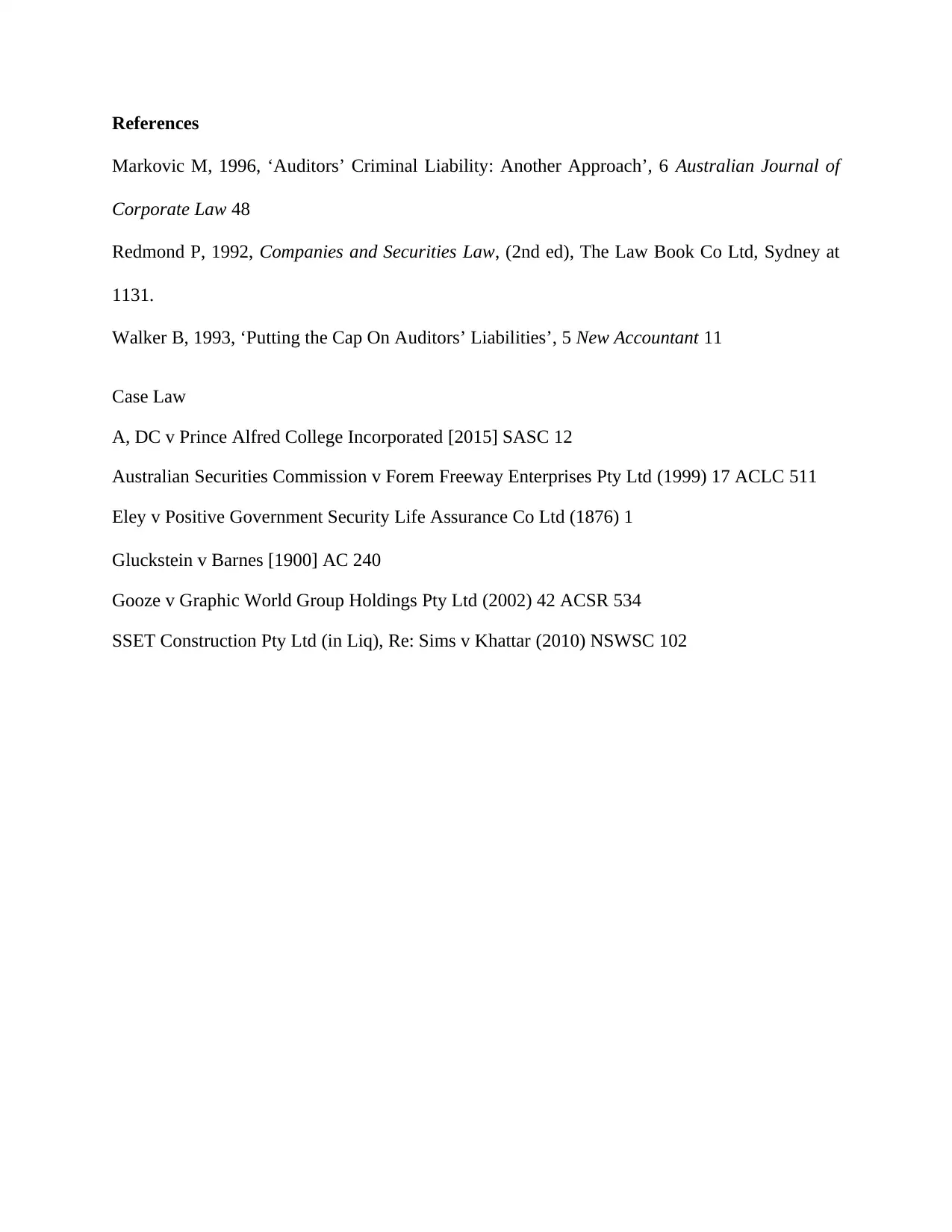
References
Markovic M, 1996, ‘Auditors’ Criminal Liability: Another Approach’, 6 Australian Journal of
Corporate Law 48
Redmond P, 1992, Companies and Securities Law, (2nd ed), The Law Book Co Ltd, Sydney at
1131.
Walker B, 1993, ‘Putting the Cap On Auditors’ Liabilities’, 5 New Accountant 11
Case Law
A, DC v Prince Alfred College Incorporated [2015] SASC 12
Australian Securities Commission v Forem Freeway Enterprises Pty Ltd (1999) 17 ACLC 511
Eley v Positive Government Security Life Assurance Co Ltd (1876) 1
Gluckstein v Barnes [1900] AC 240
Gooze v Graphic World Group Holdings Pty Ltd (2002) 42 ACSR 534
SSET Construction Pty Ltd (in Liq), Re: Sims v Khattar (2010) NSWSC 102
Markovic M, 1996, ‘Auditors’ Criminal Liability: Another Approach’, 6 Australian Journal of
Corporate Law 48
Redmond P, 1992, Companies and Securities Law, (2nd ed), The Law Book Co Ltd, Sydney at
1131.
Walker B, 1993, ‘Putting the Cap On Auditors’ Liabilities’, 5 New Accountant 11
Case Law
A, DC v Prince Alfred College Incorporated [2015] SASC 12
Australian Securities Commission v Forem Freeway Enterprises Pty Ltd (1999) 17 ACLC 511
Eley v Positive Government Security Life Assurance Co Ltd (1876) 1
Gluckstein v Barnes [1900] AC 240
Gooze v Graphic World Group Holdings Pty Ltd (2002) 42 ACSR 534
SSET Construction Pty Ltd (in Liq), Re: Sims v Khattar (2010) NSWSC 102
1 out of 29
Your All-in-One AI-Powered Toolkit for Academic Success.
+13062052269
info@desklib.com
Available 24*7 on WhatsApp / Email
![[object Object]](/_next/static/media/star-bottom.7253800d.svg)
Unlock your academic potential
© 2024 | Zucol Services PVT LTD | All rights reserved.